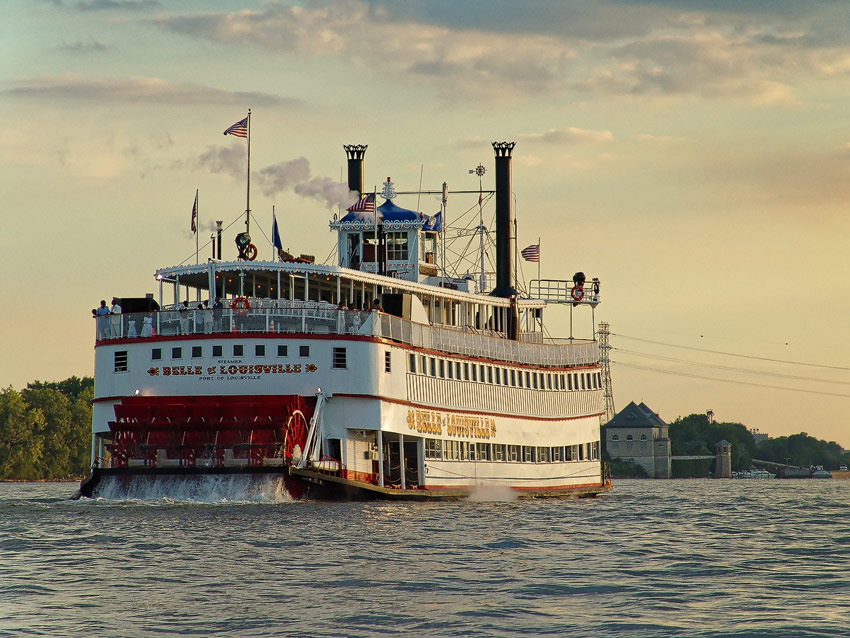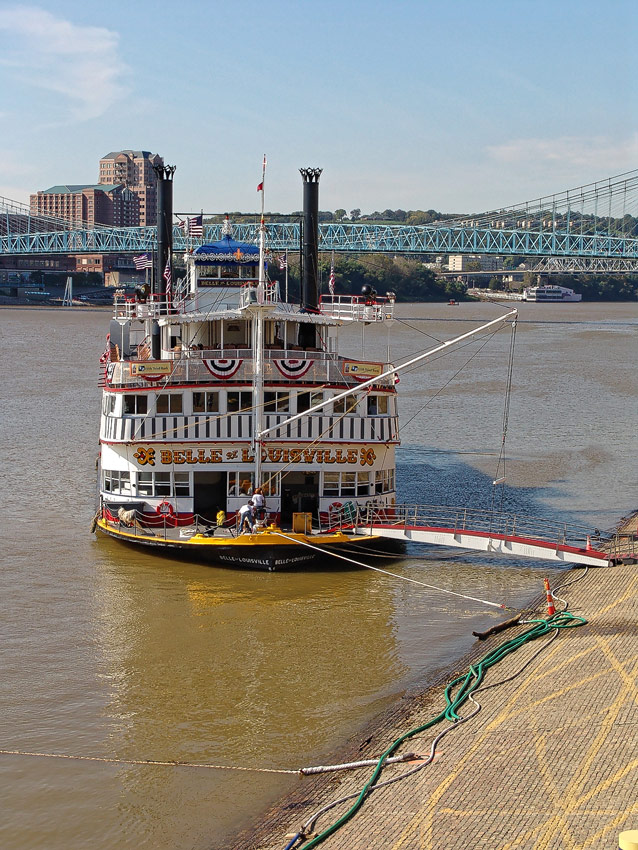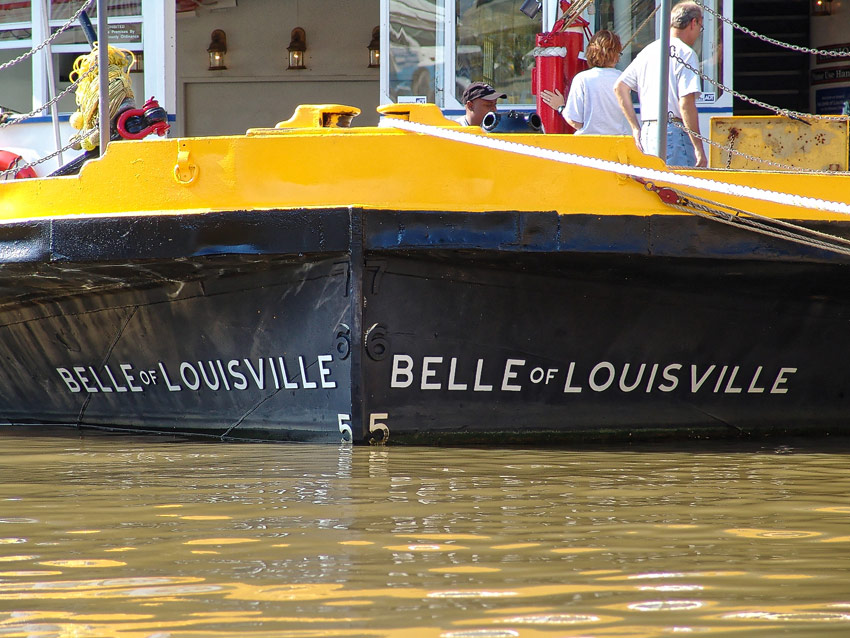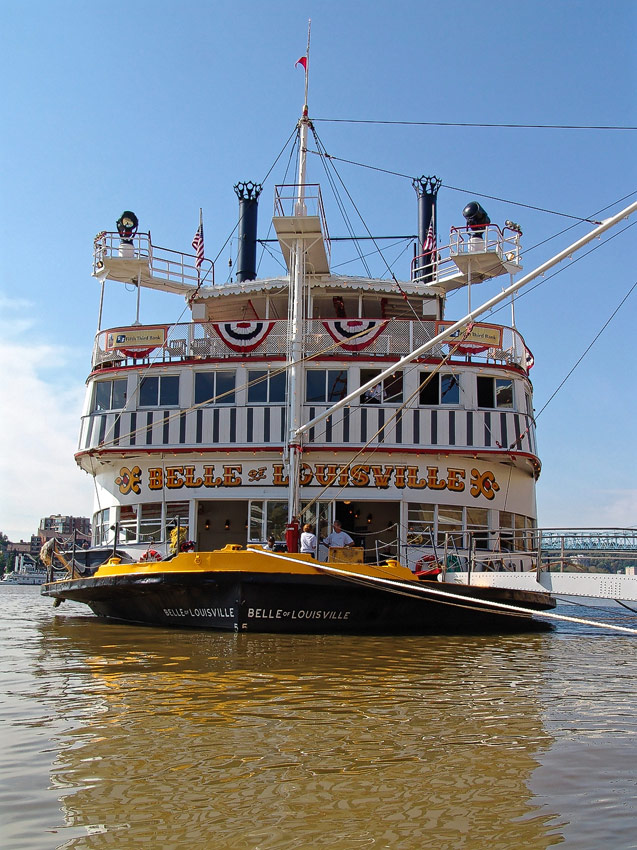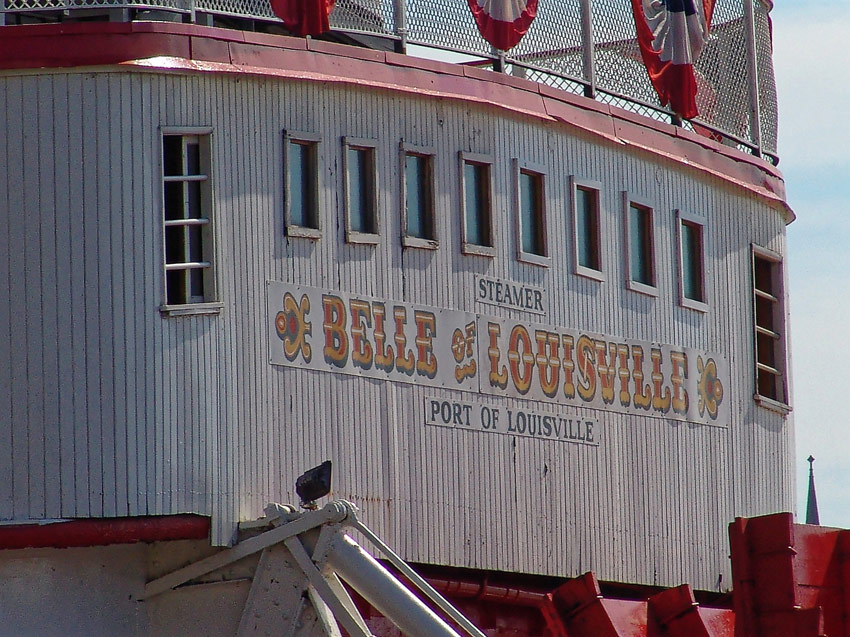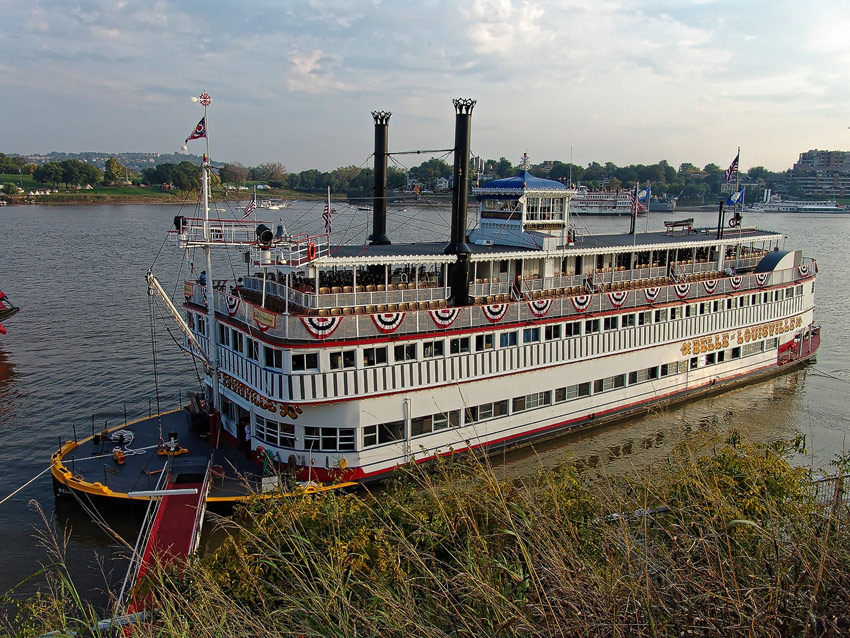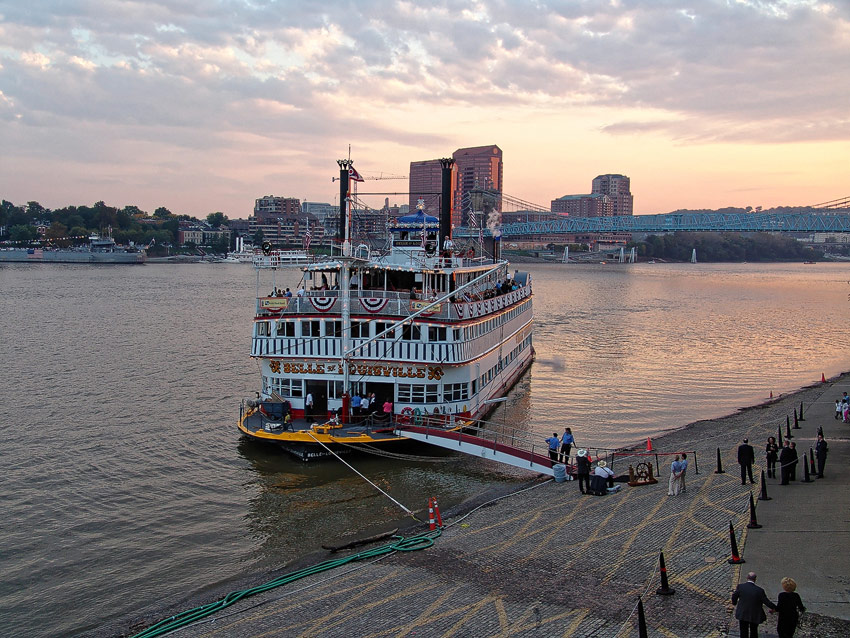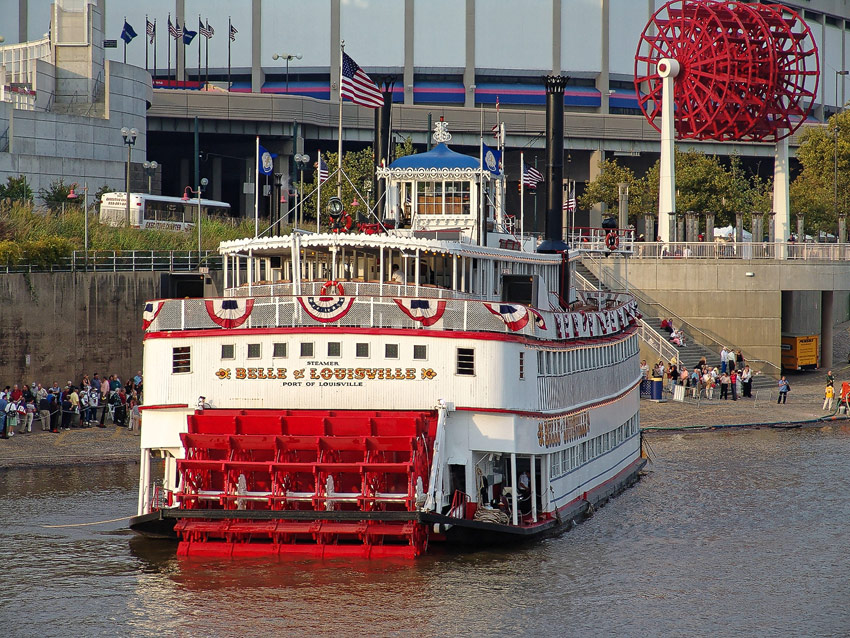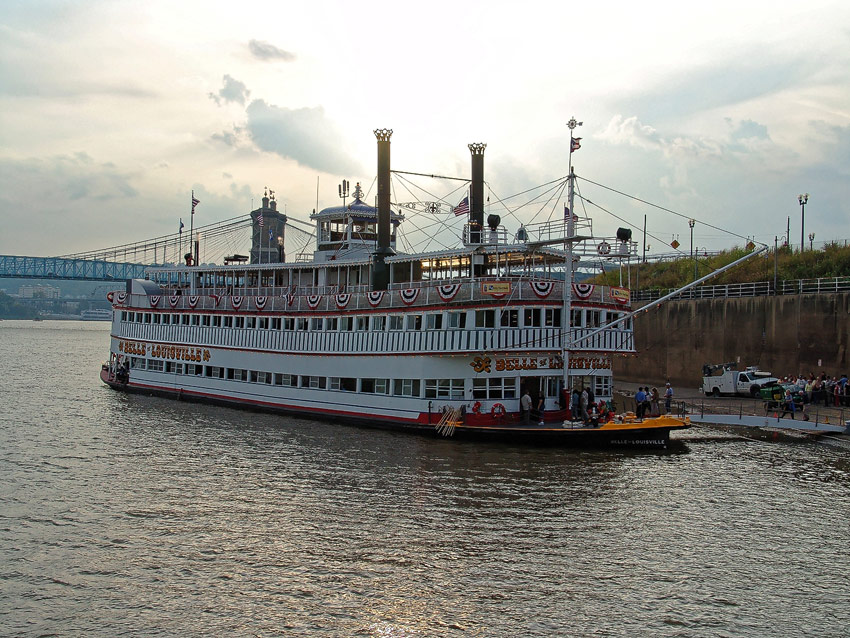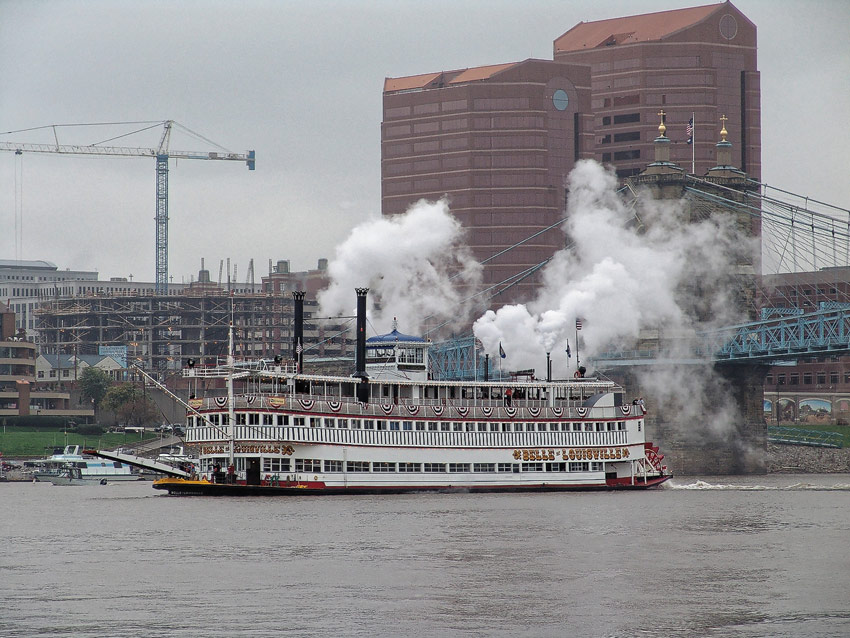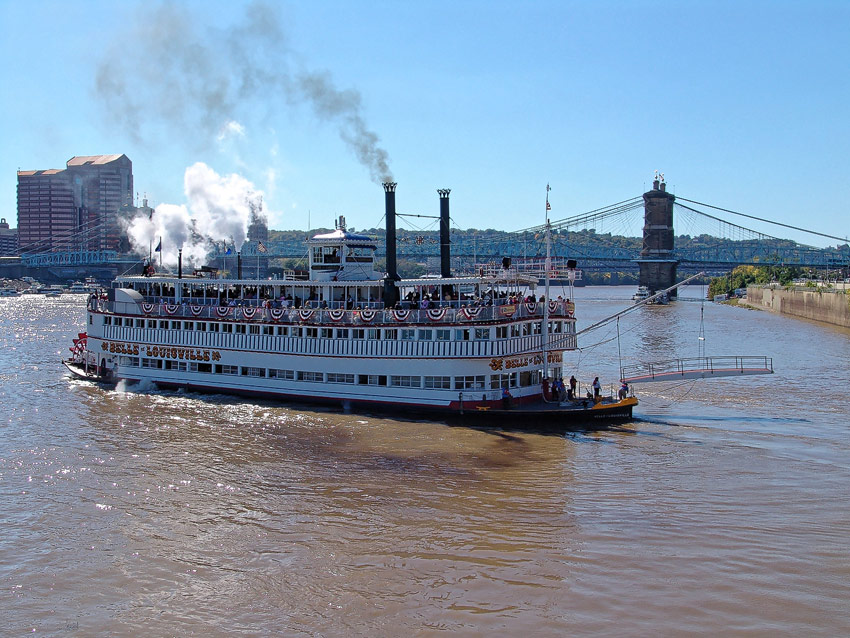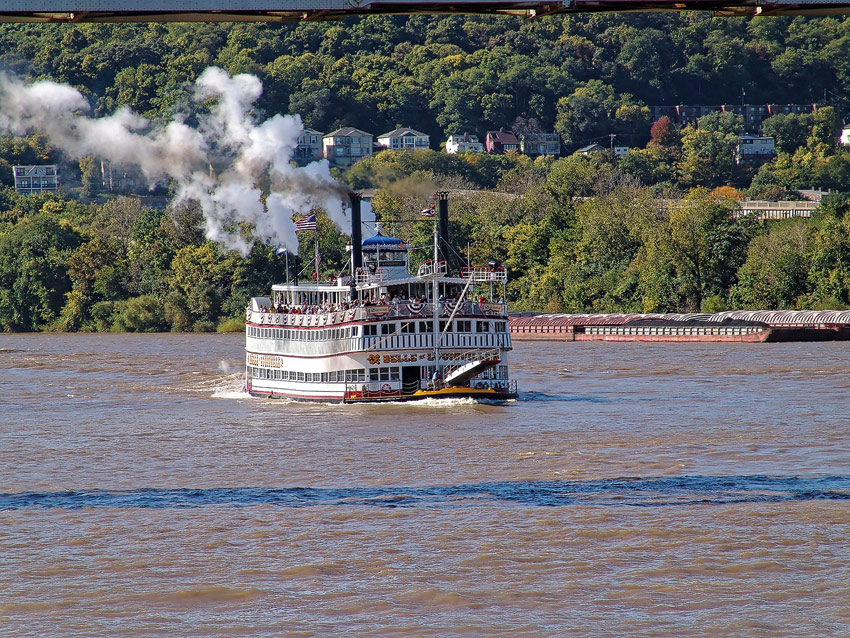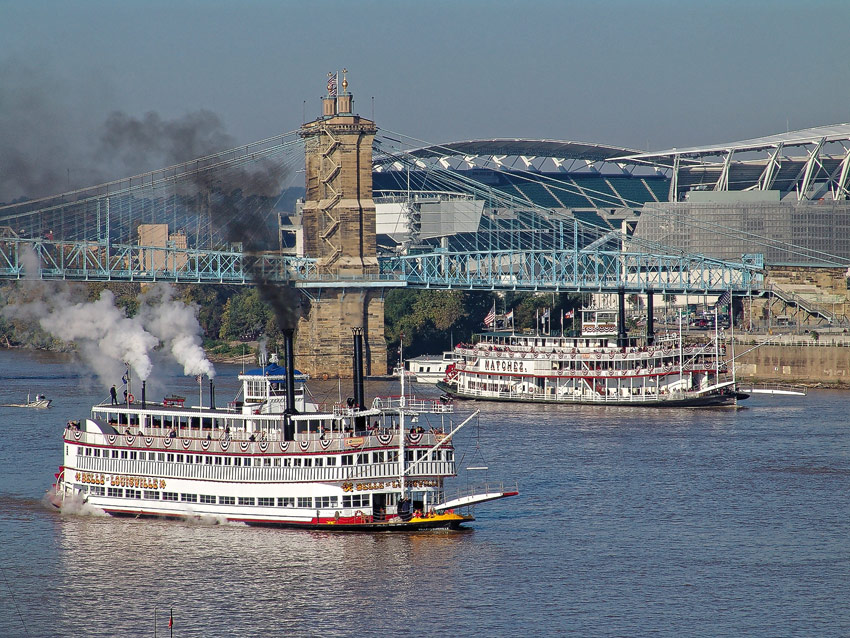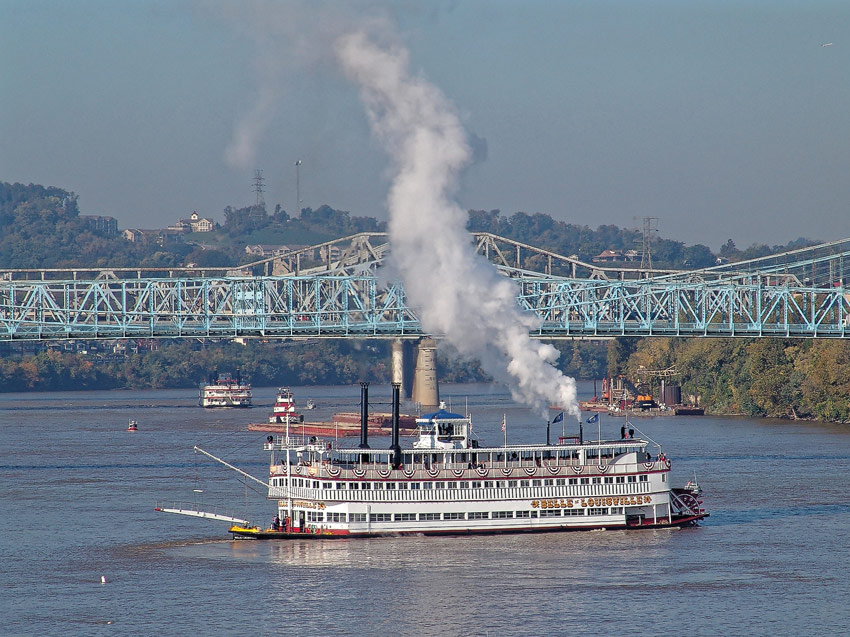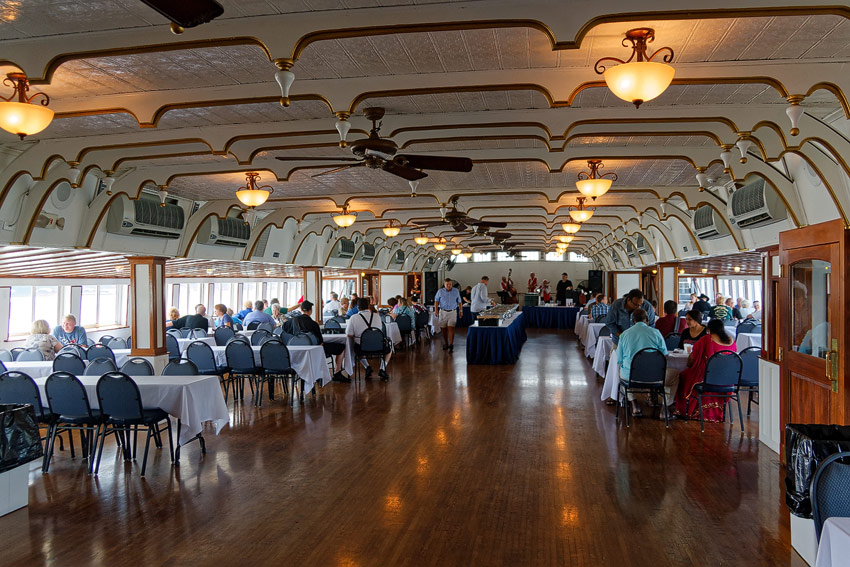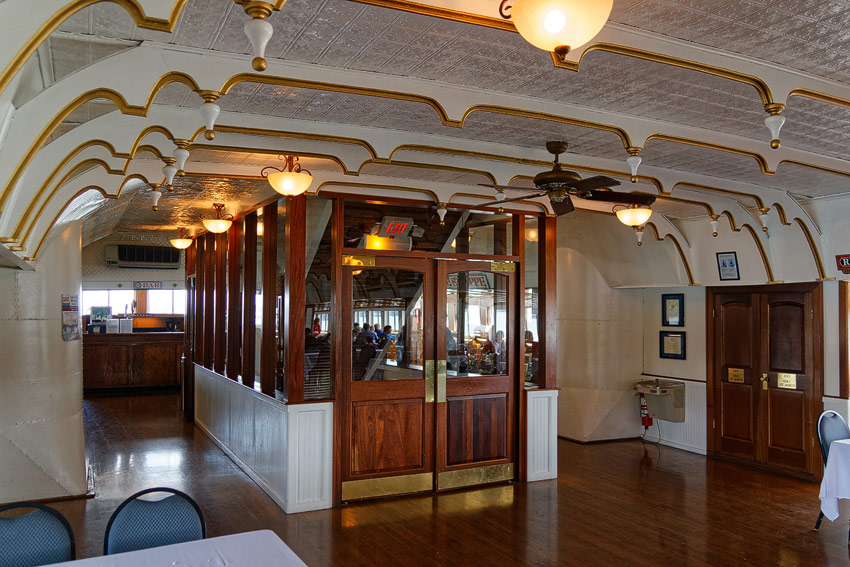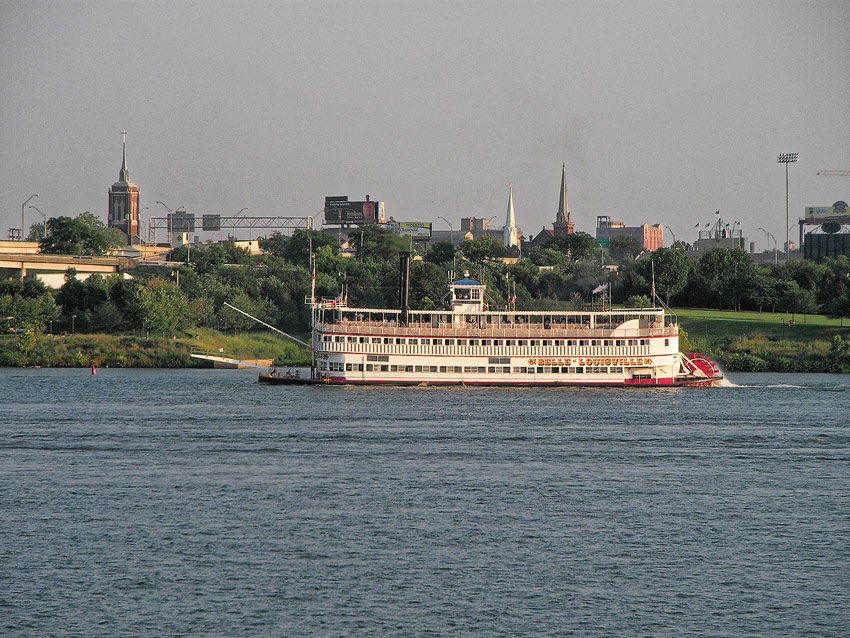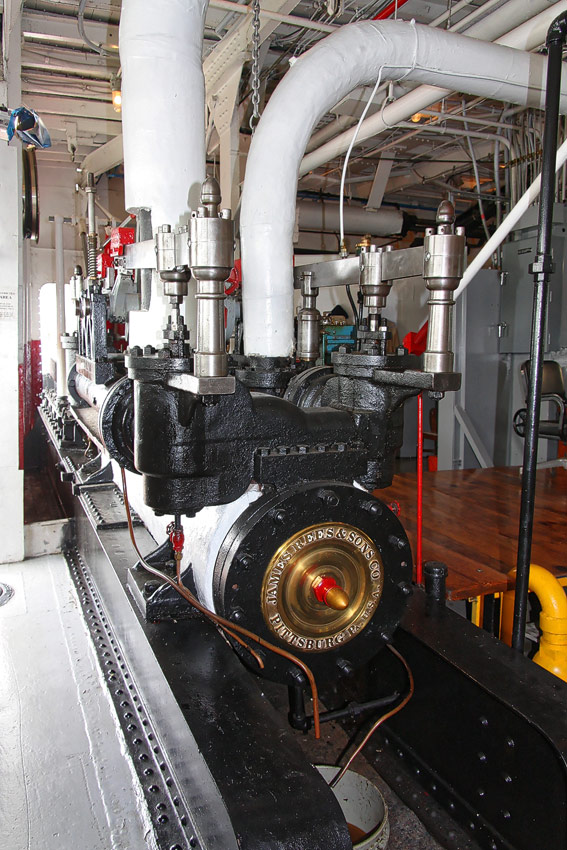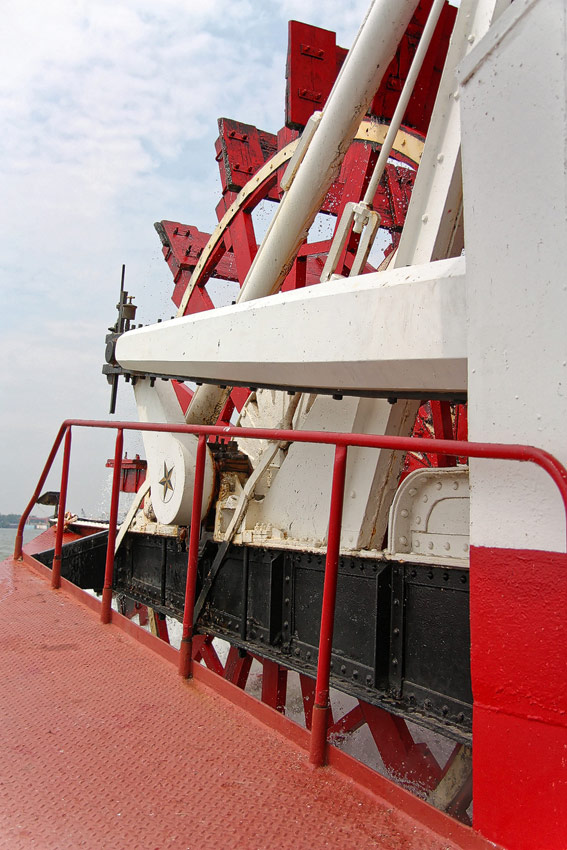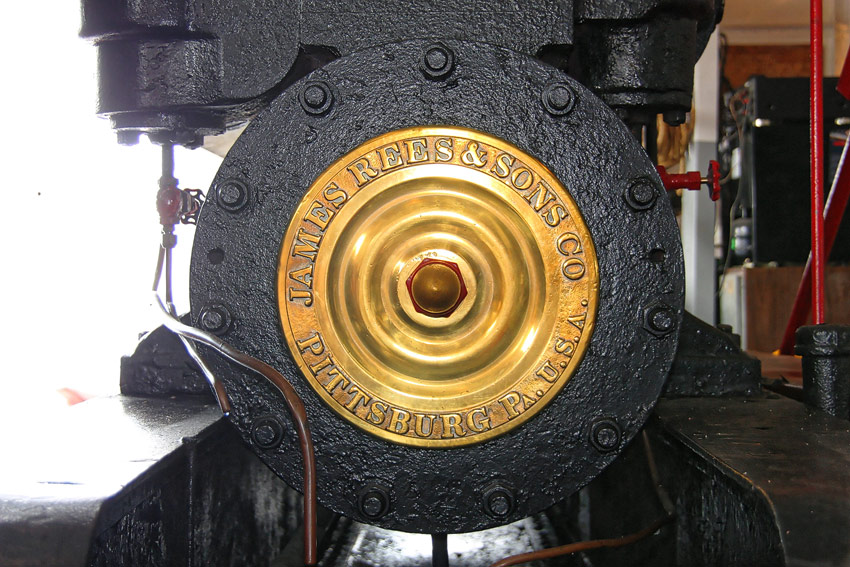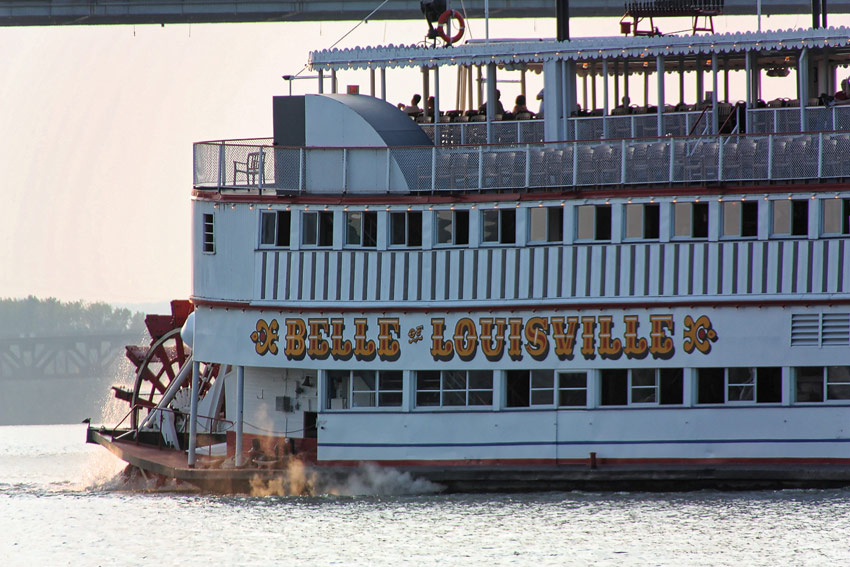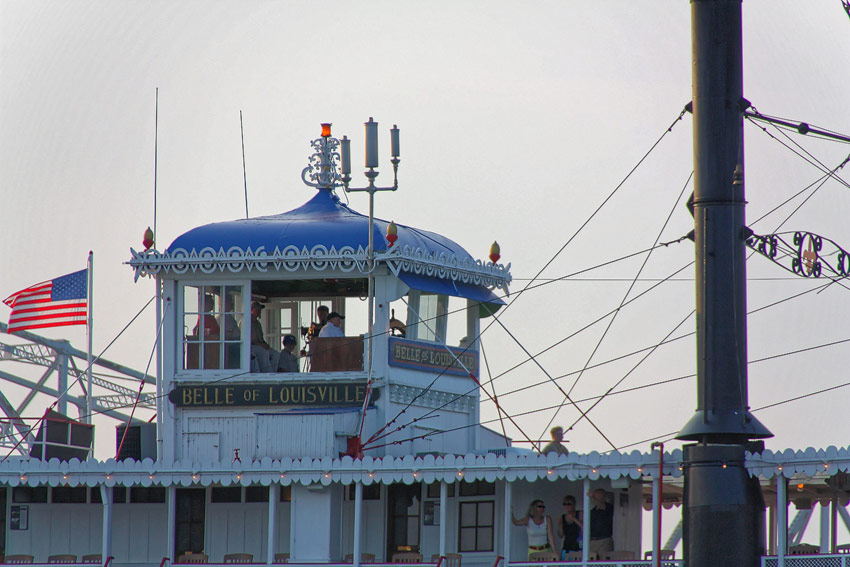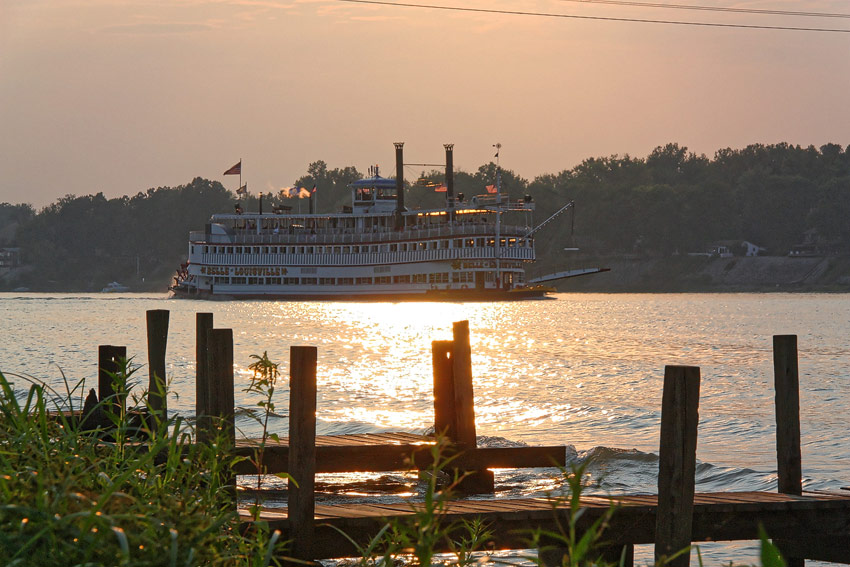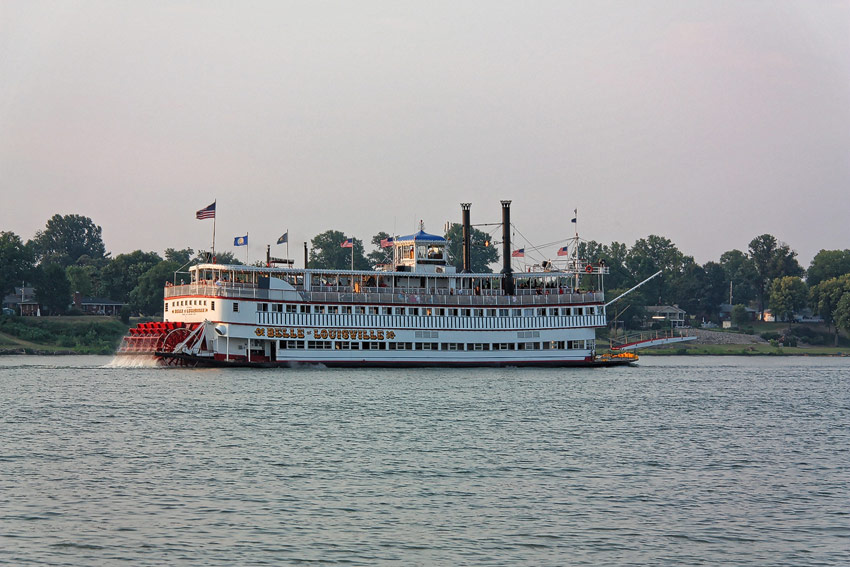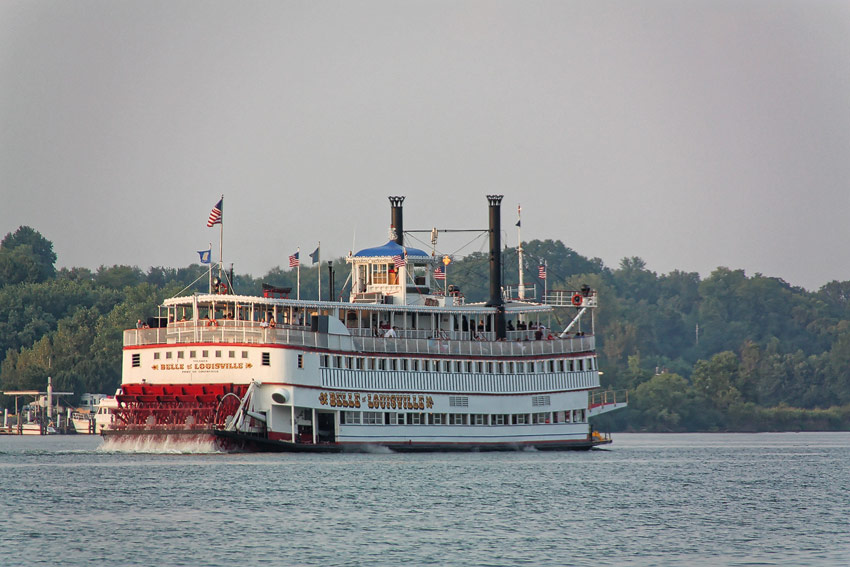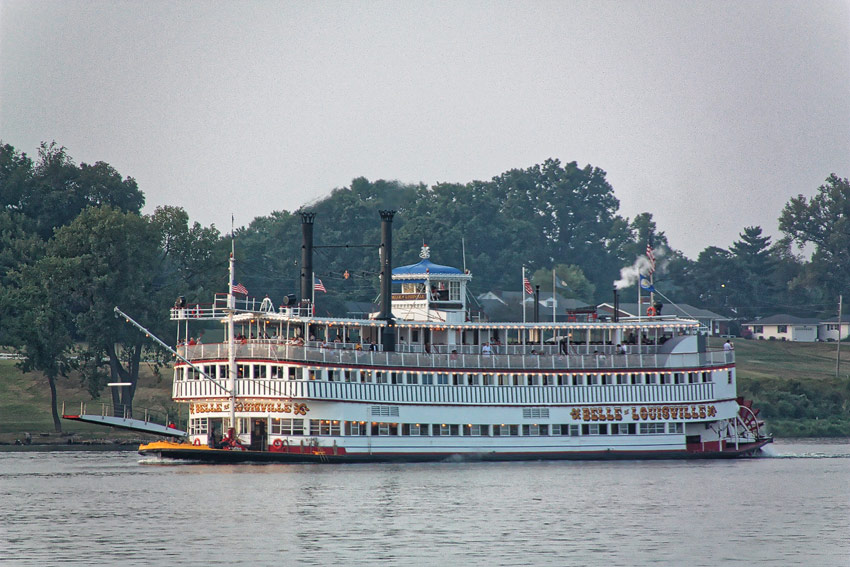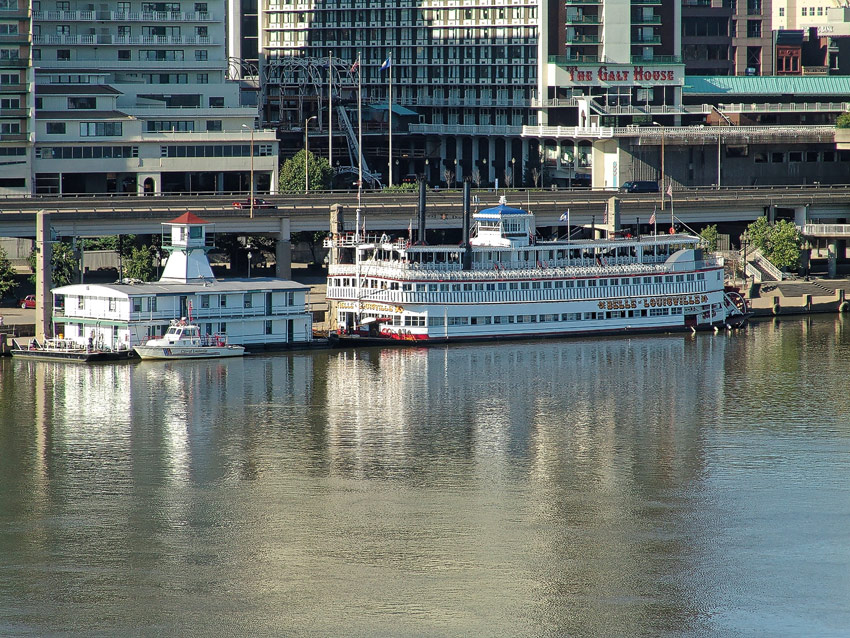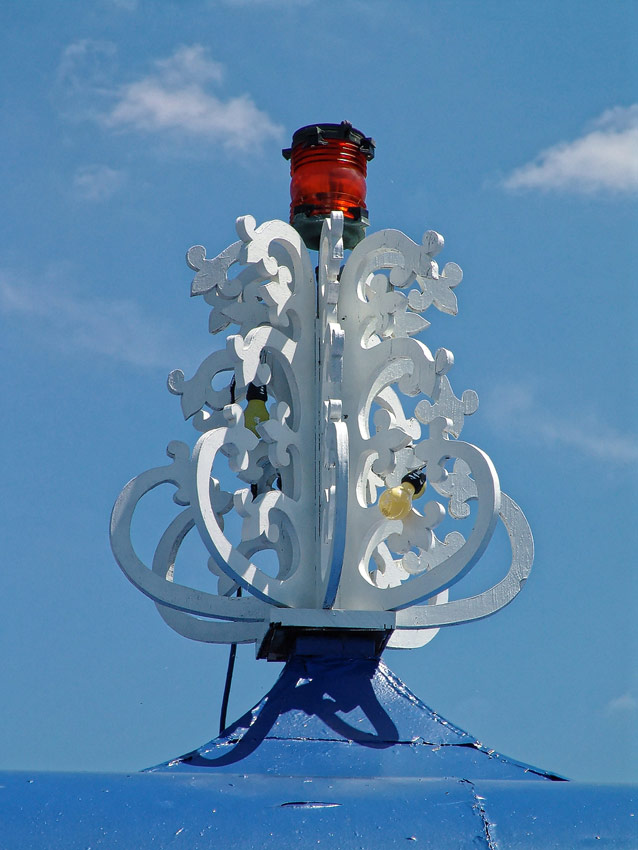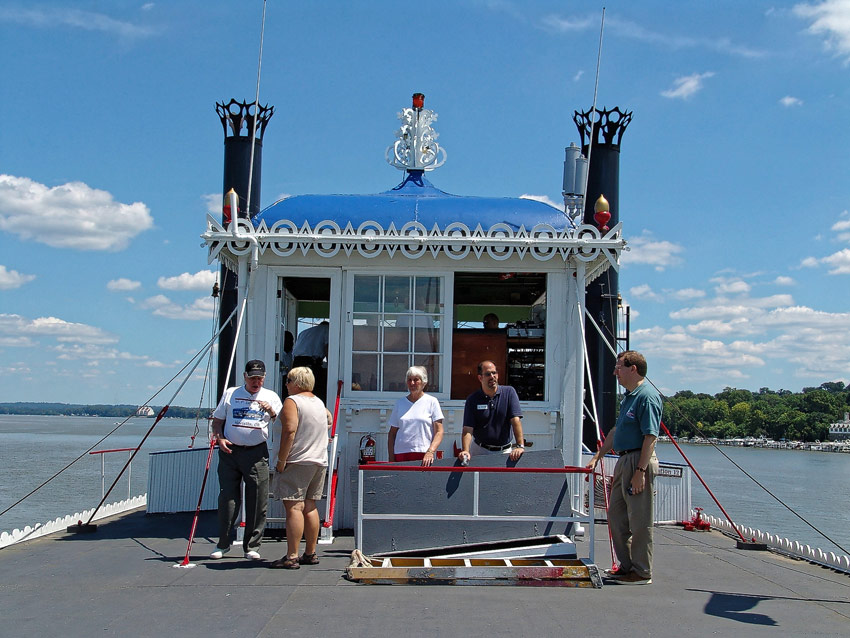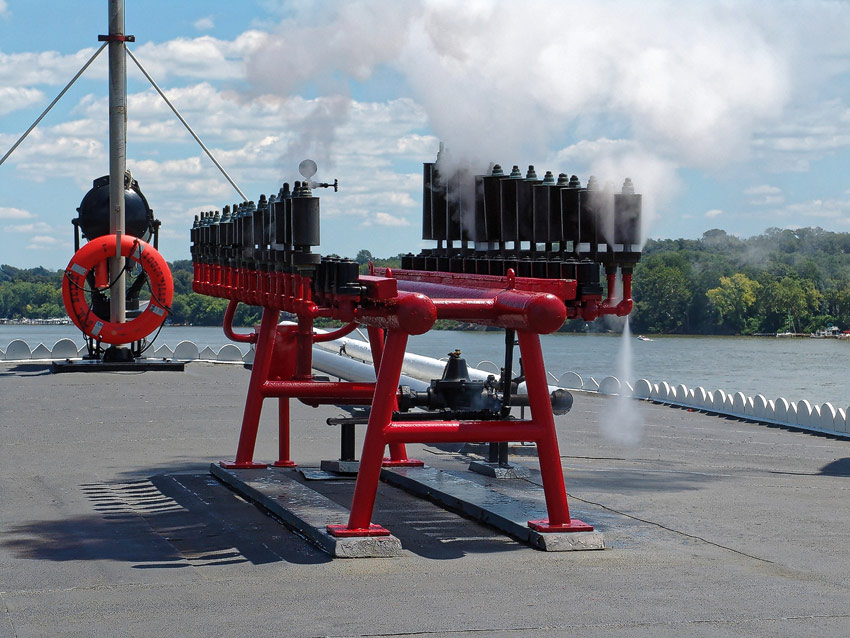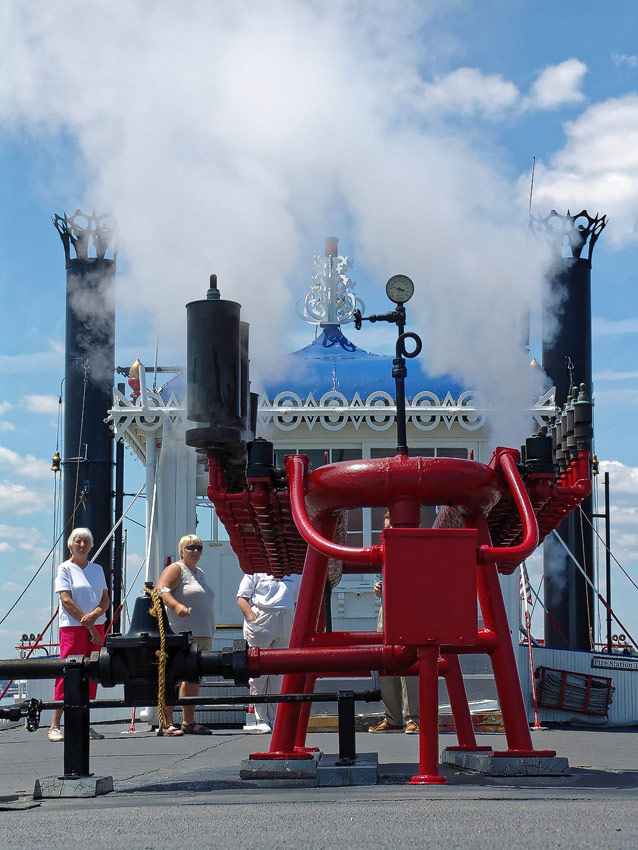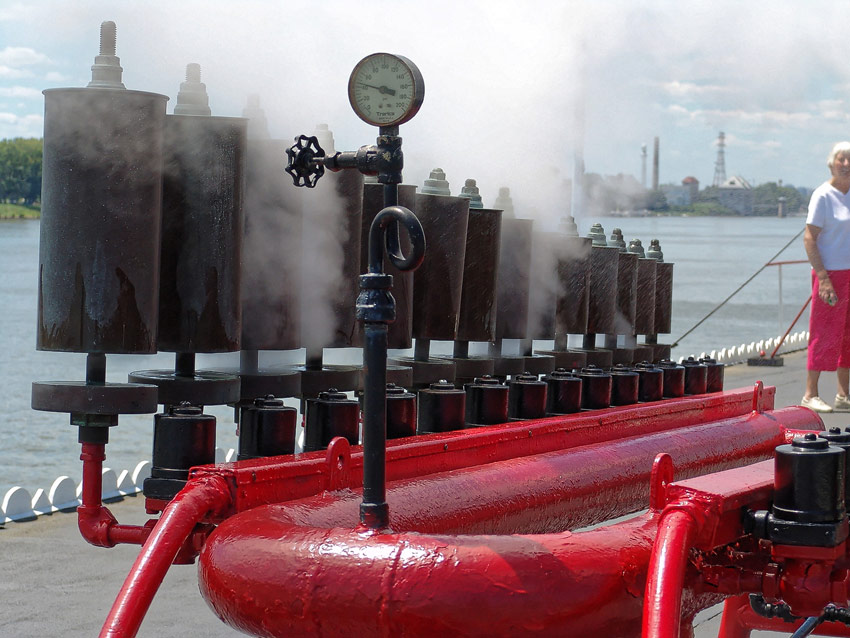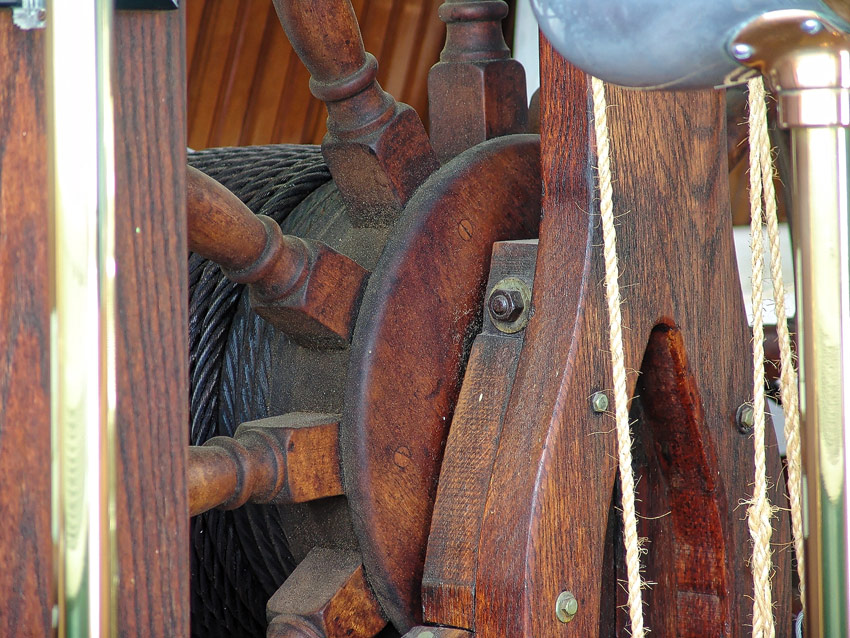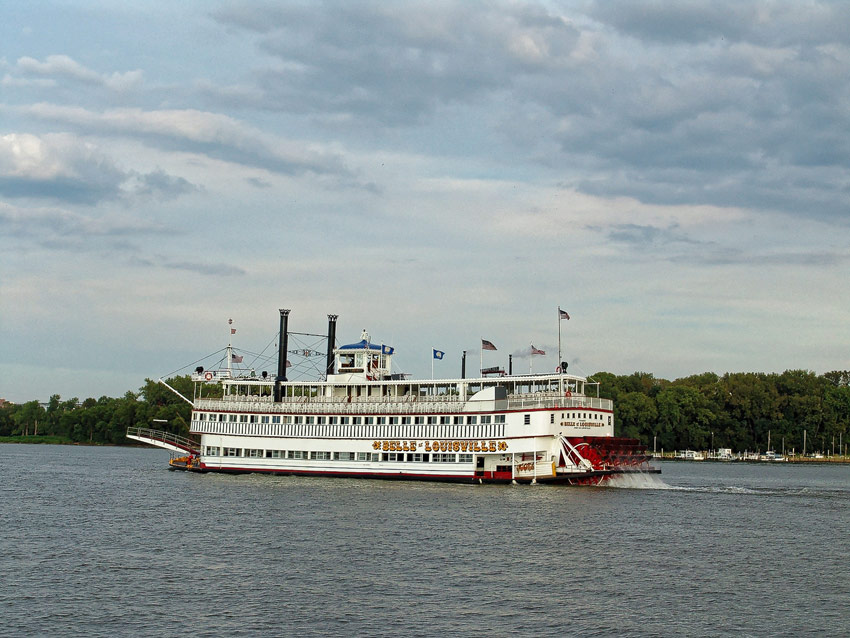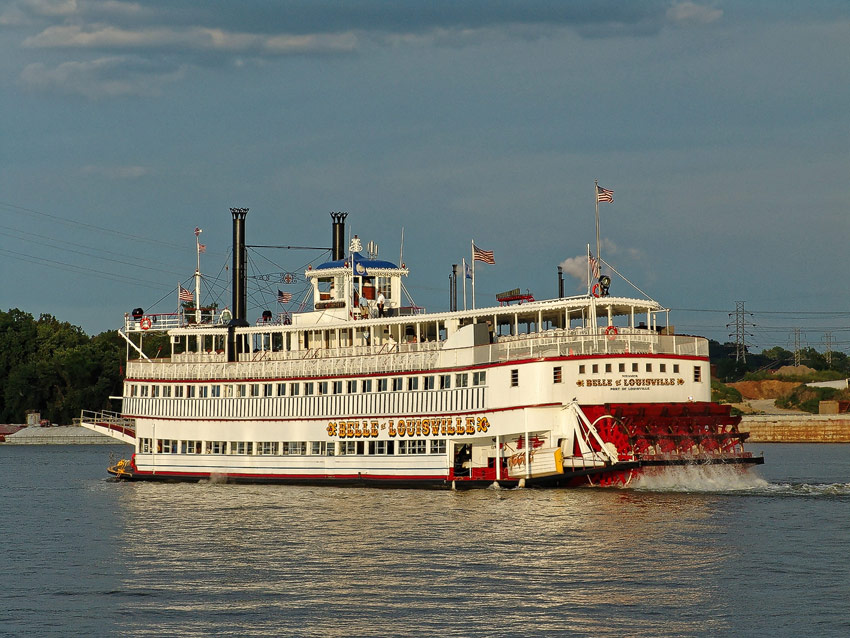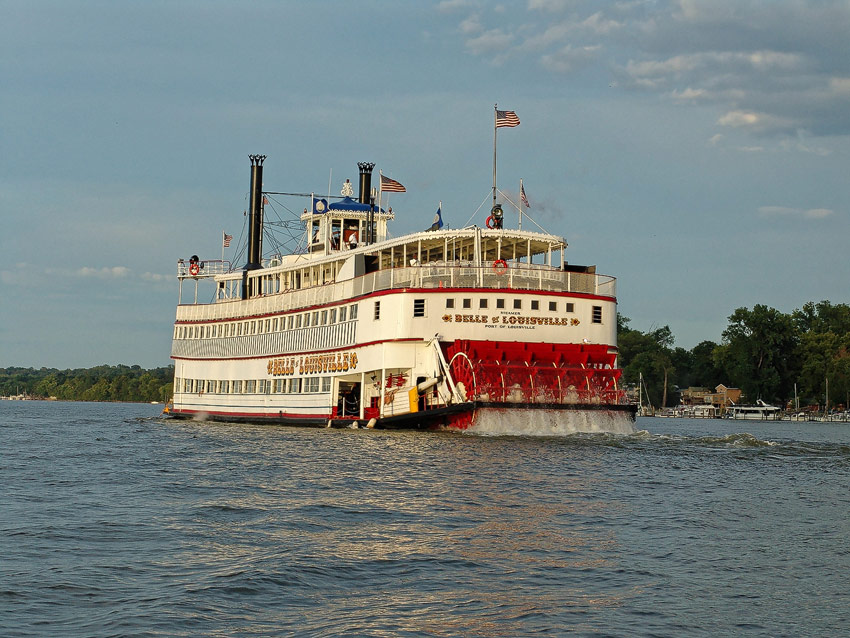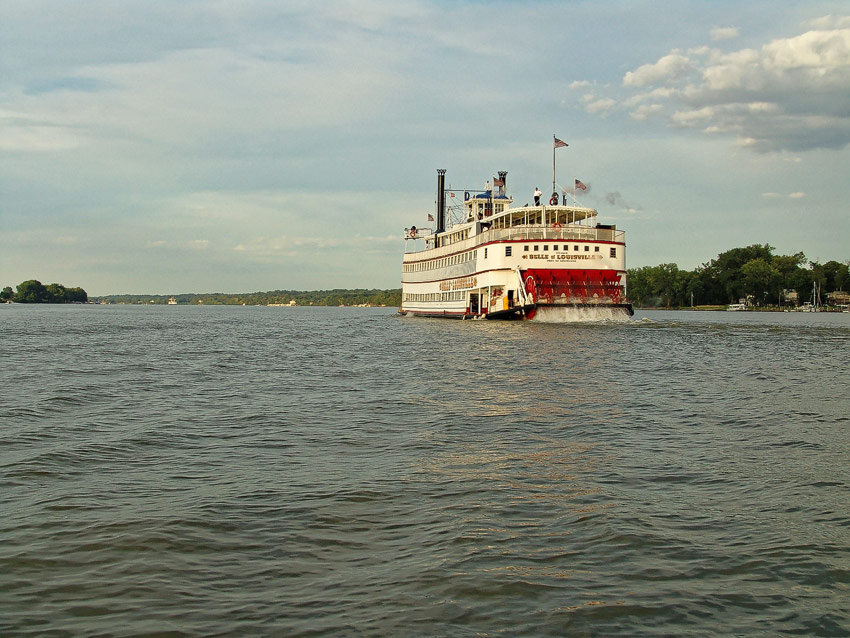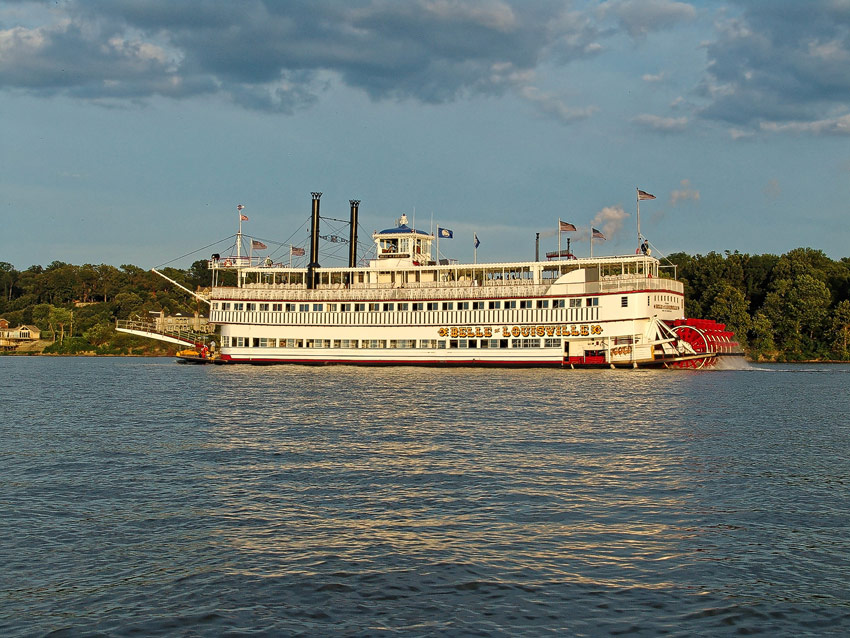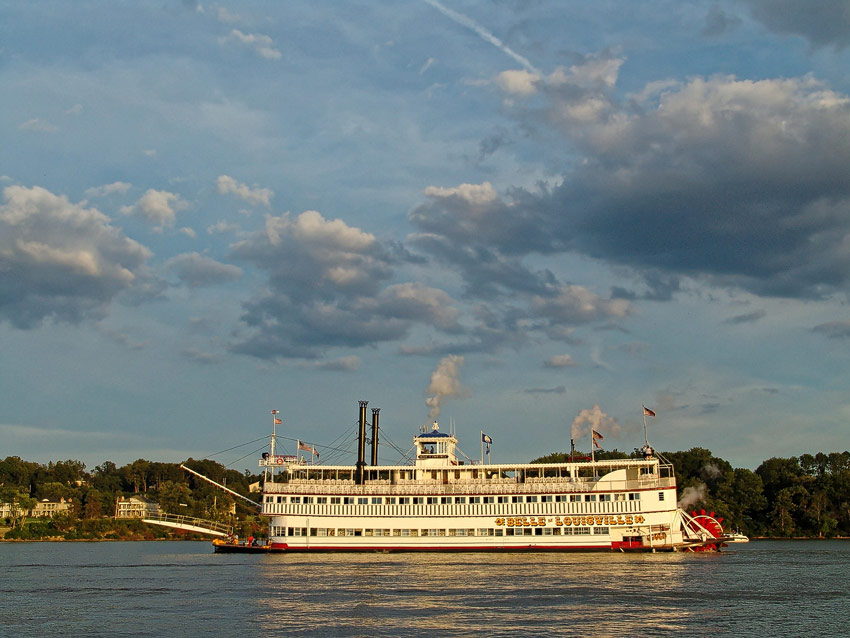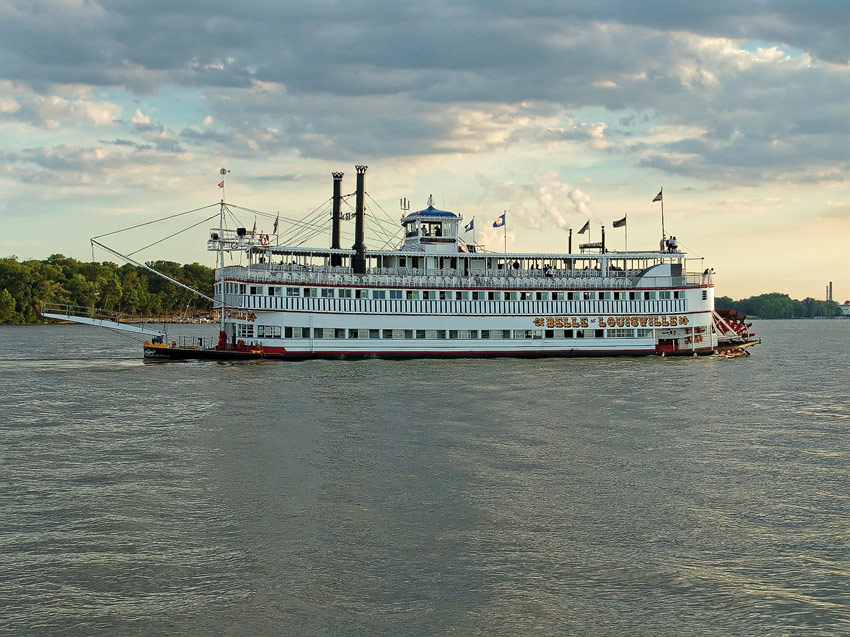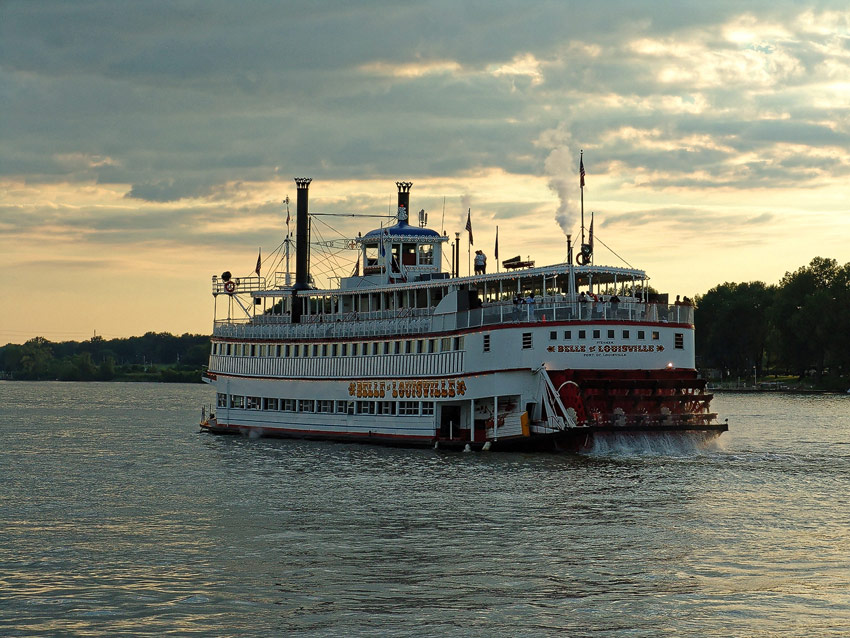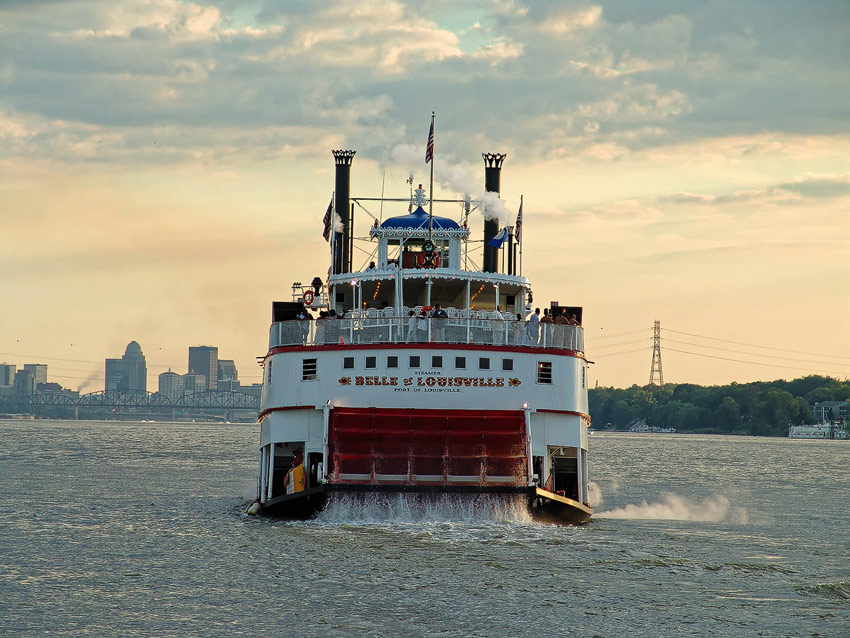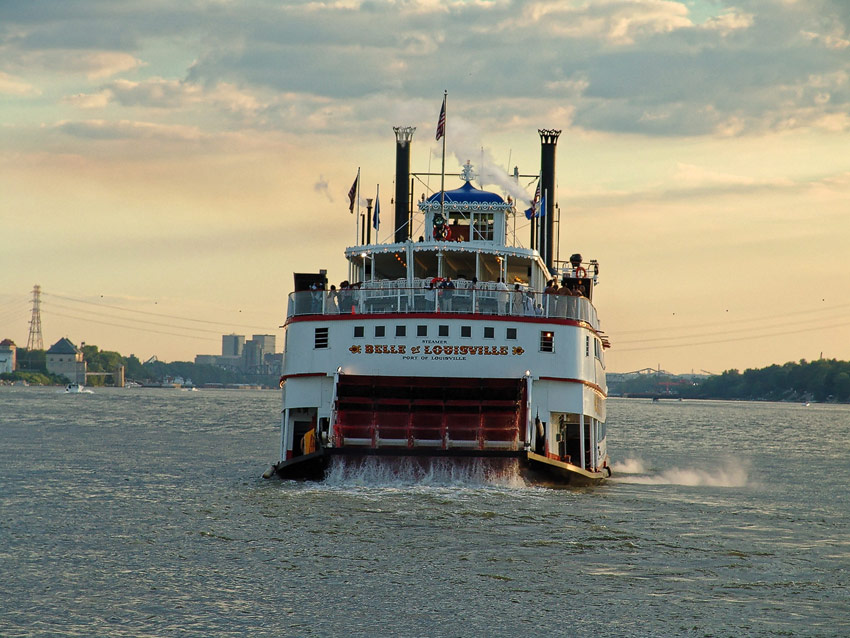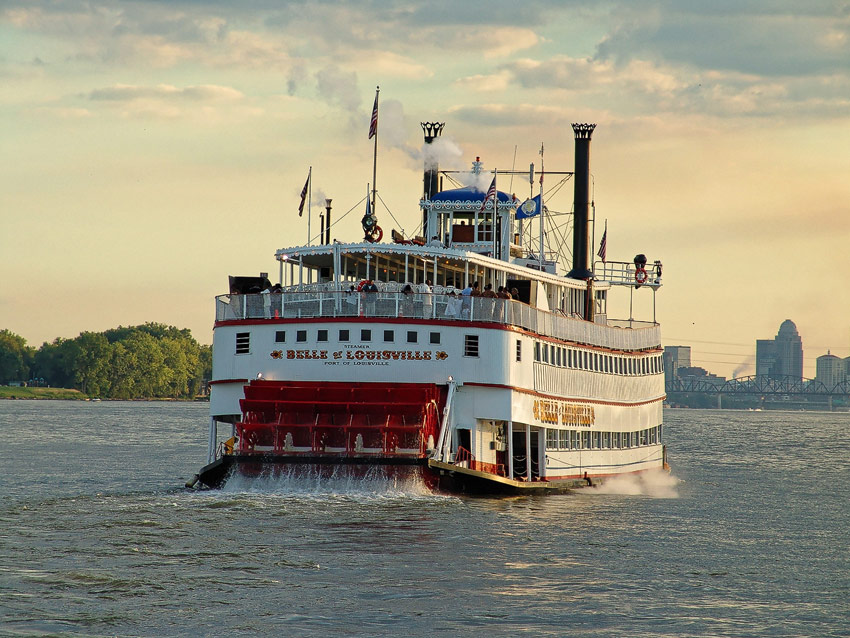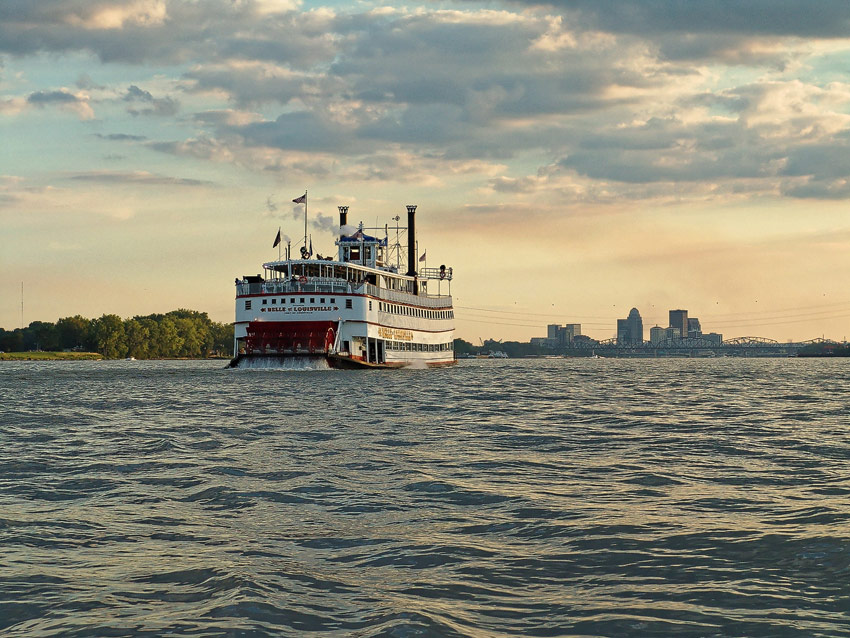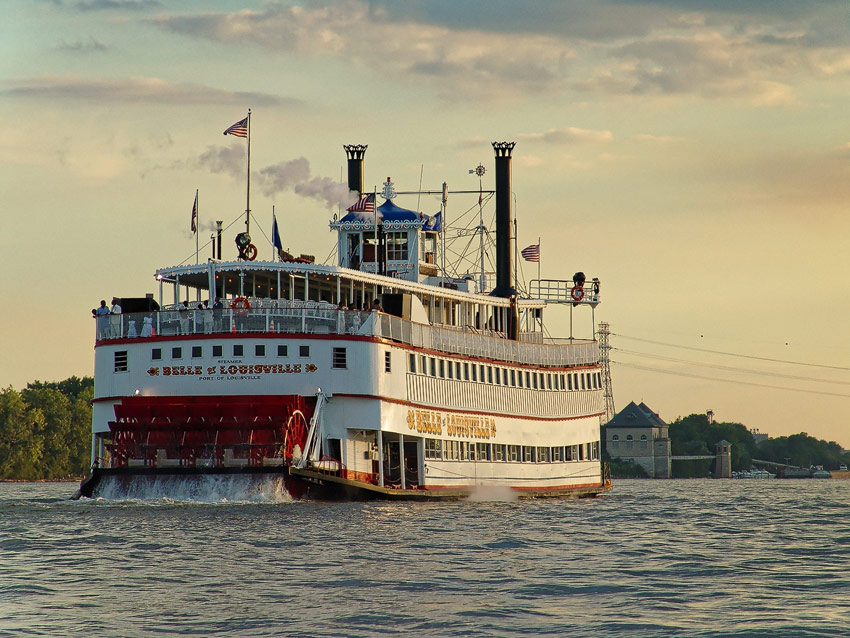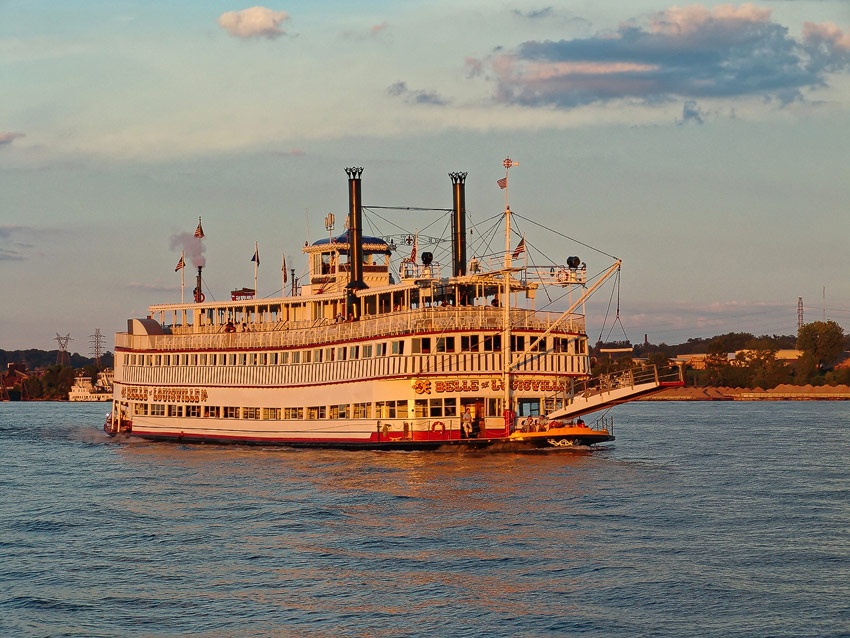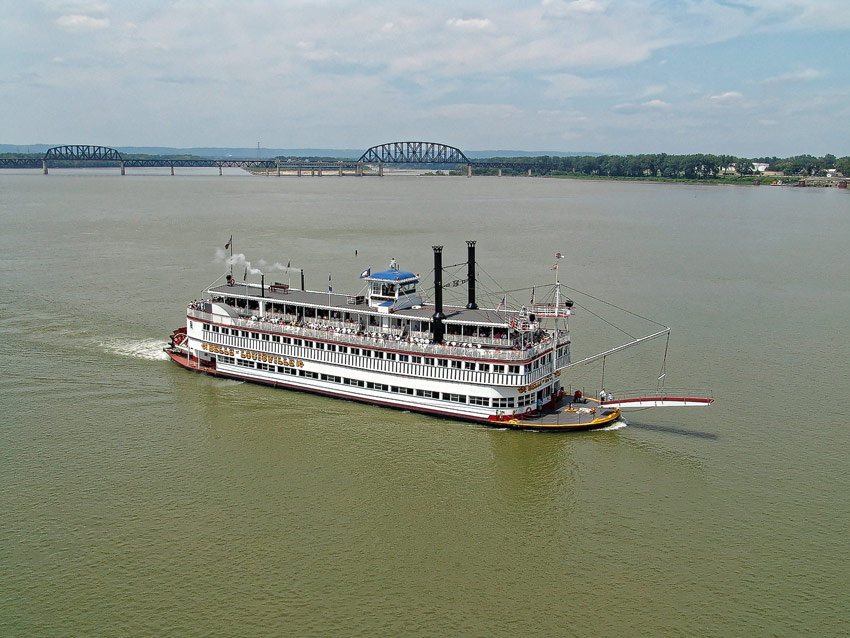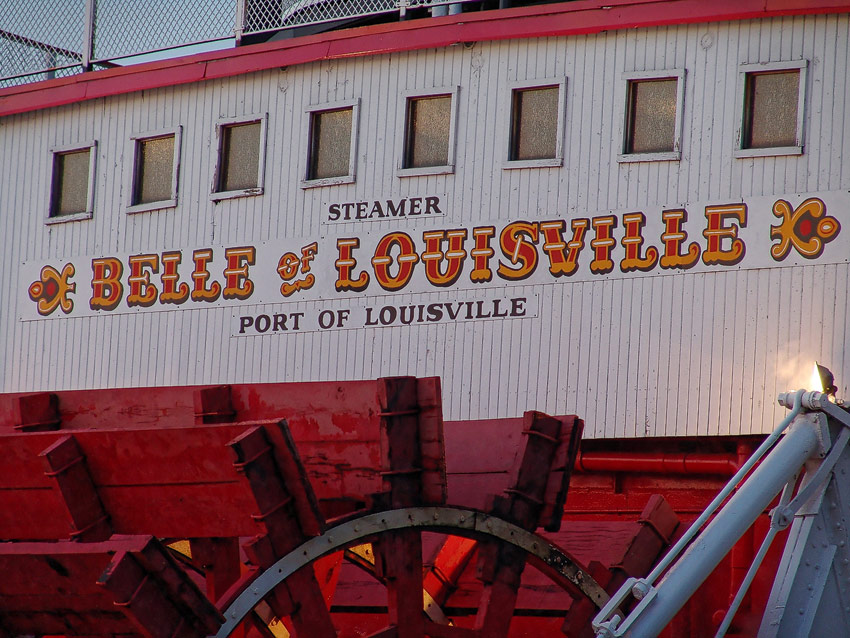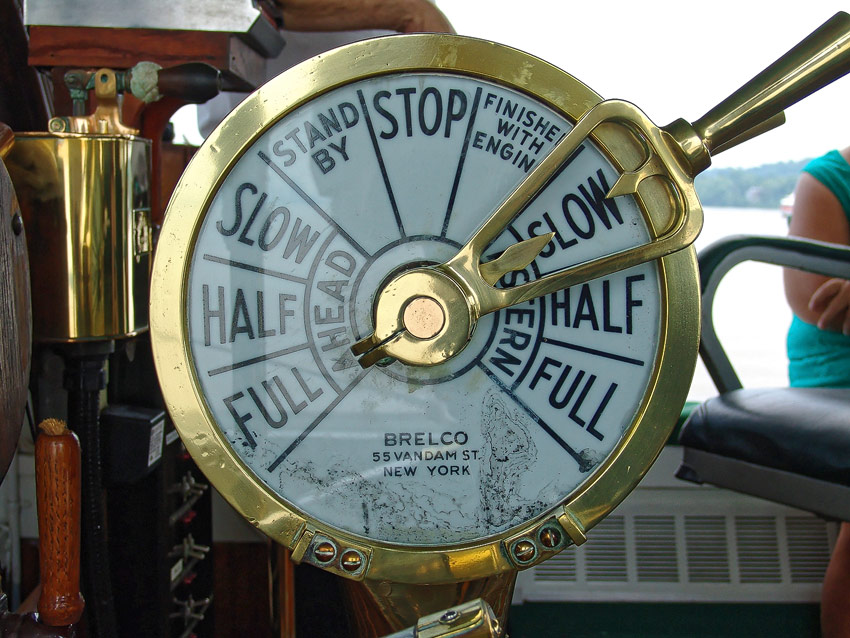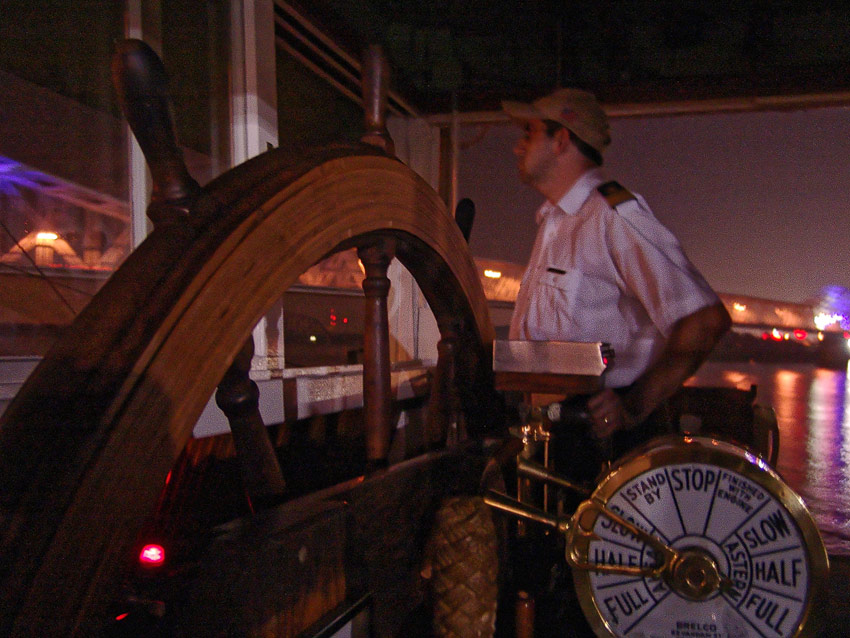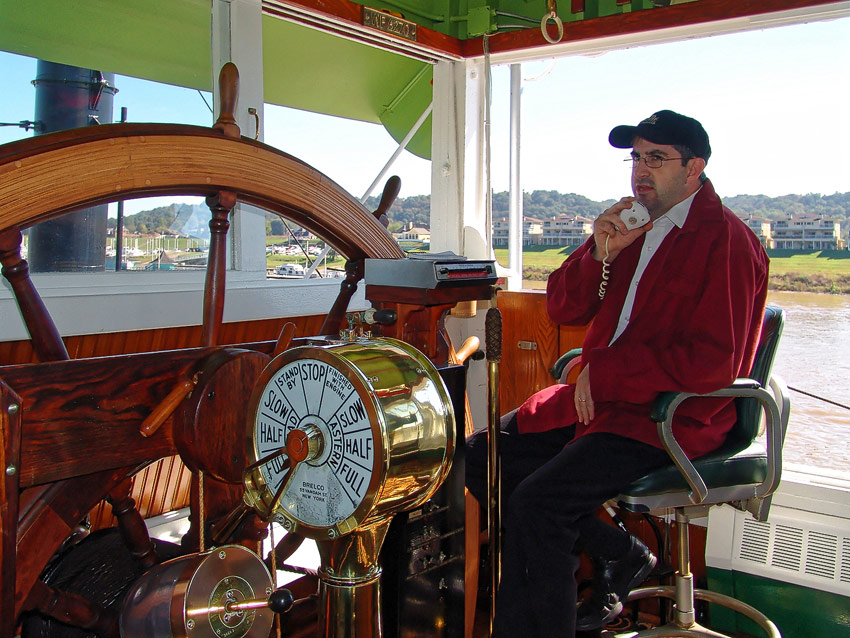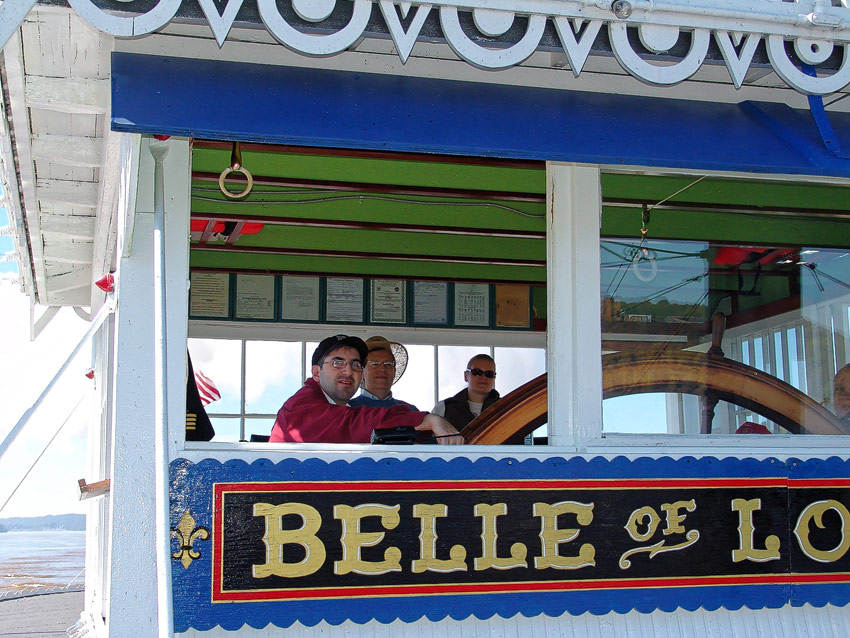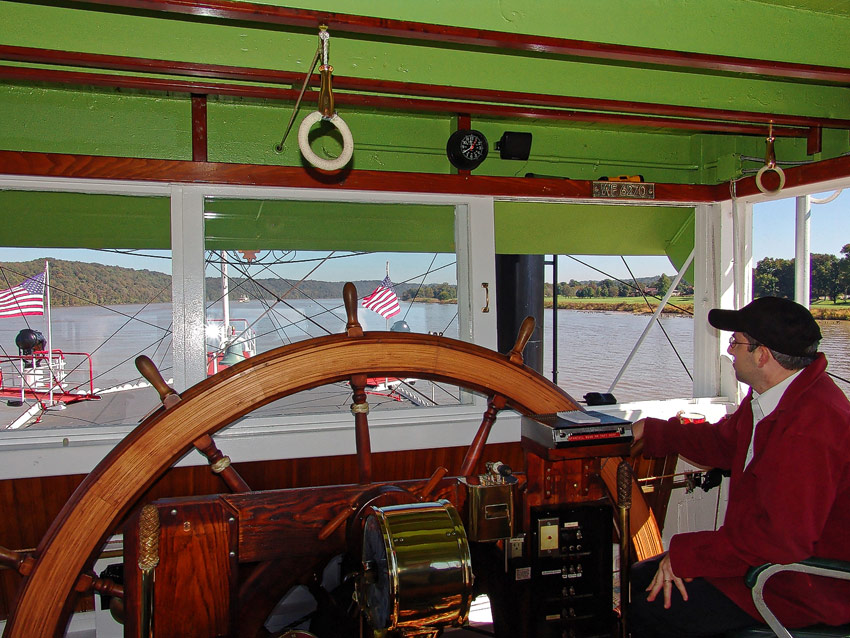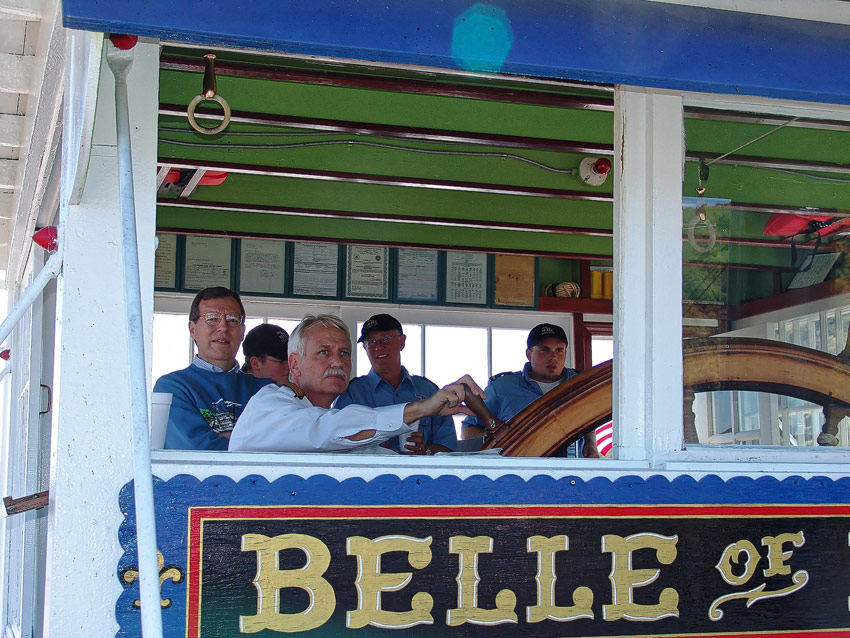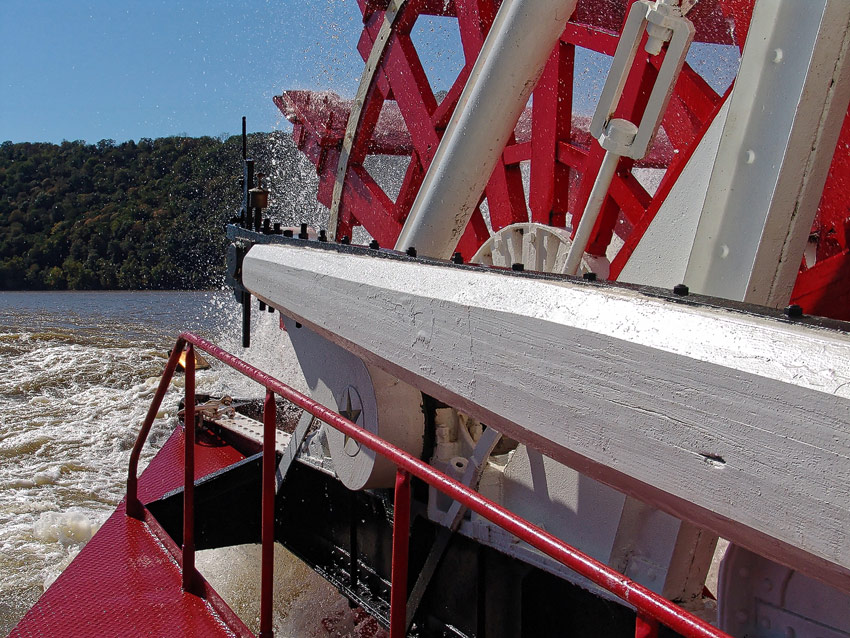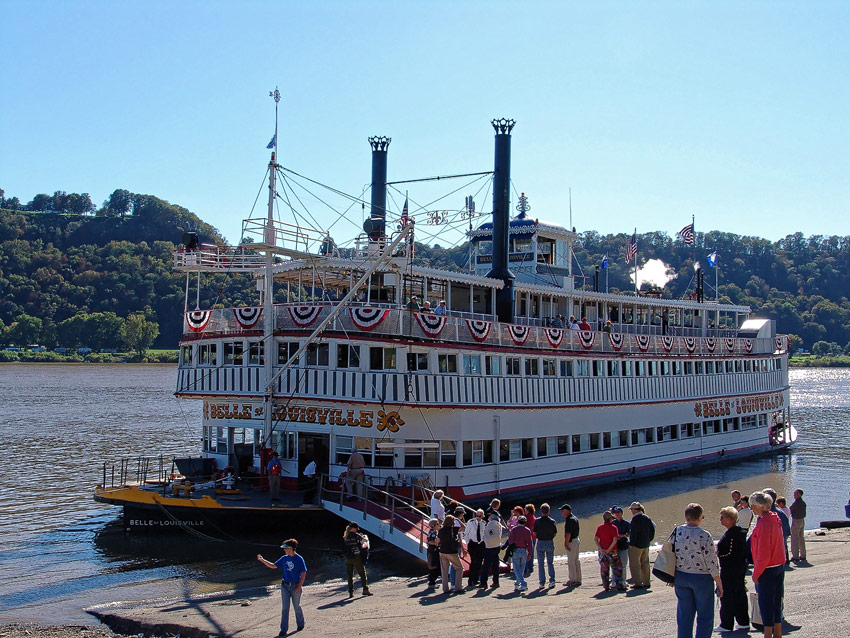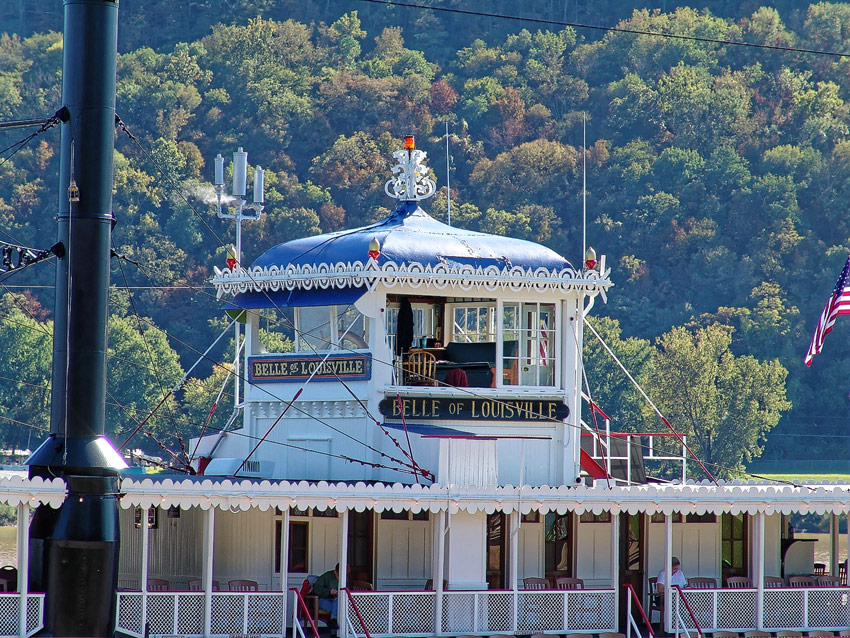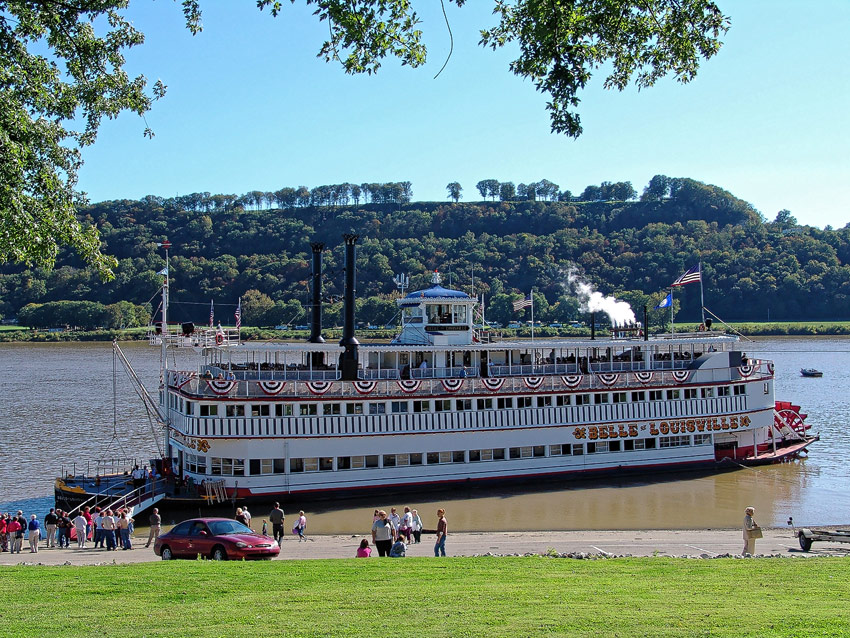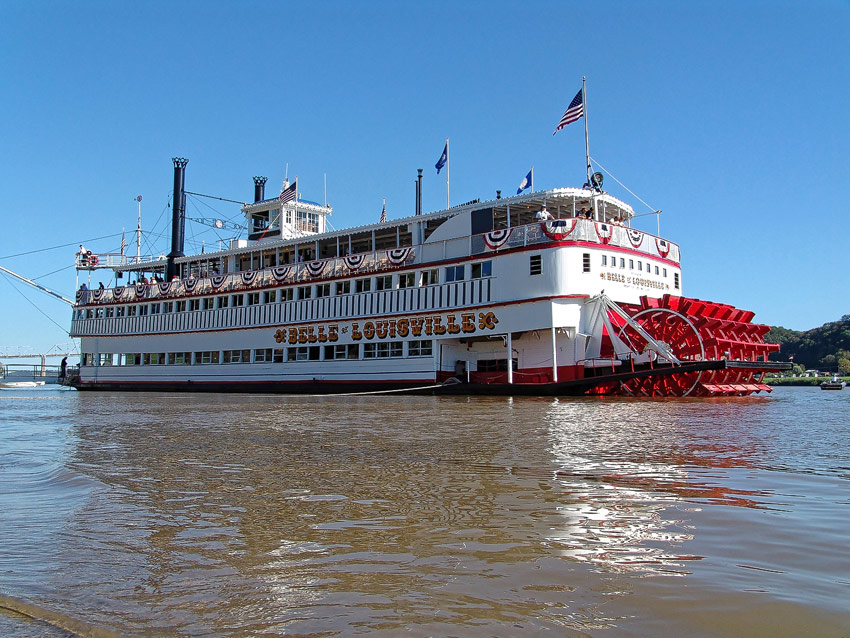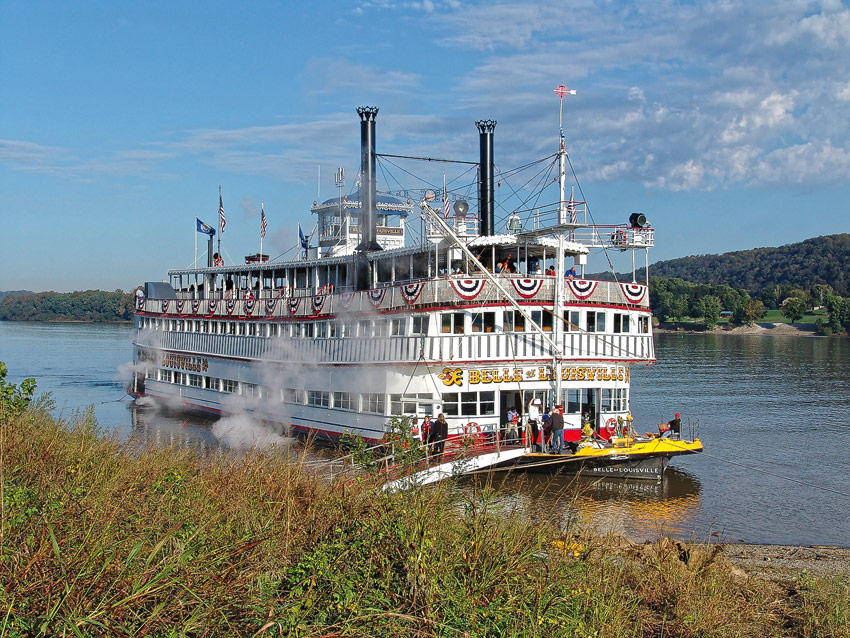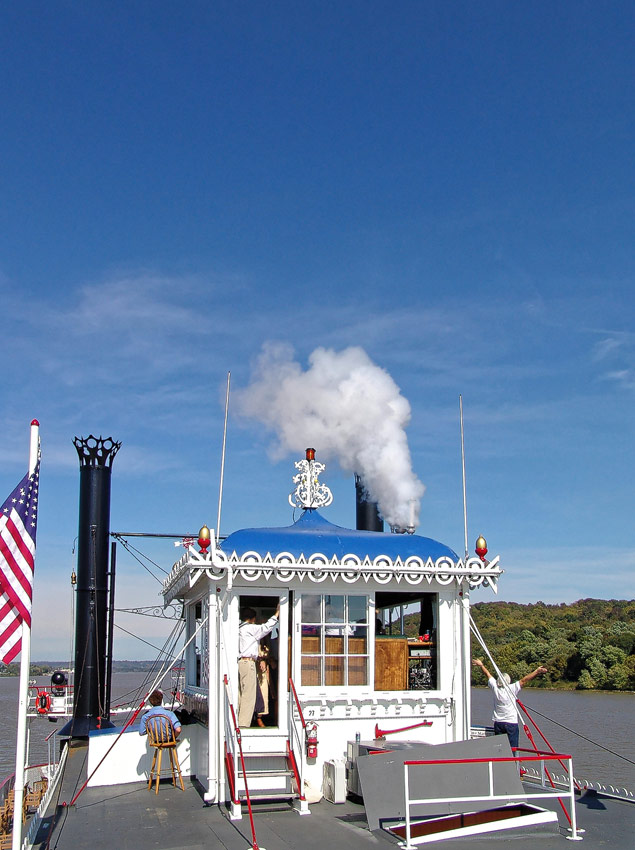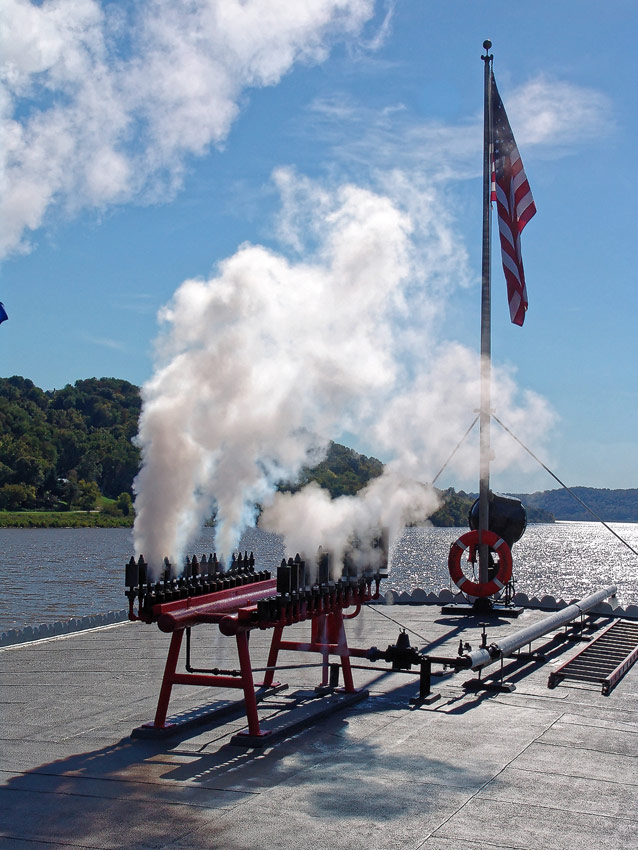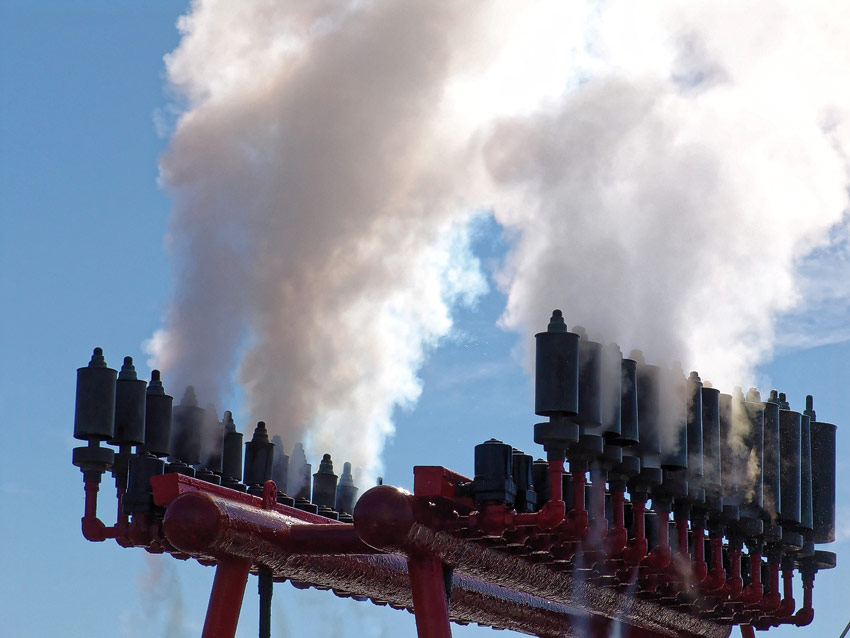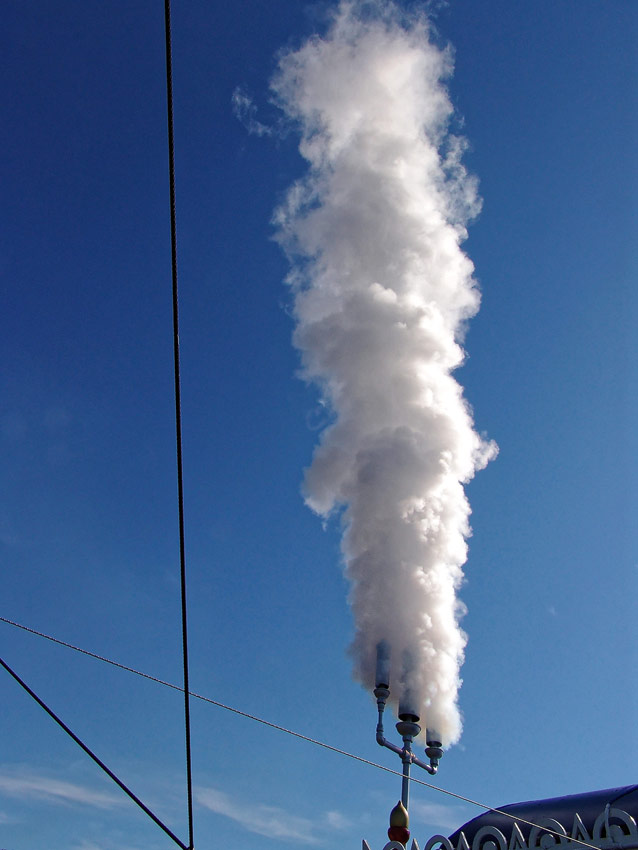Louisville, KY
The Belle of Louisville was originally built as Idlewild in 1914 by James Rees & Sons of Pittsburgh, PA, for the Memphis Packet Co. She left Pittsburgh for Memphis, TN, on January 9, 1915. In February 1928, she was sold to the New St. Louis & Calhoun Country Packet Co., Hardin, IL. In April 1947, she was again sold to J. Herod Gorsage, Peoria, IL. There she got her second name Avalon in February 1948. She was sold in 1950 to the Steamer Avalon Inc. of Cincinnati, OH, to serve as excursion boat. In 1962 the boat was sold to Jefferson County Fiscal Court and renamed Belle of Louisville, based in Louisville, KY.
On April 31, 1963, the Belle of Louisville ran a staged race against the Delta Queen and lost. Since then this race is an annual event which is taking place a few days prior to the Kentucky Derby. Due to the bankruptcy of the parental company of the Delta Queen Steamboat Co., the Americal Classical Voyages, in October, 2001, there won´t be that race in 2002. The MV Belle of Cincinnati will take the place of the Delta Queen. But the race will be on in 2003.
In 1968 the Belle of Louisville was extensively rebuilt at Jeffboat Inc. of Jeffersonville, IN. Her hull was lengthened to 191′ 2”.
The Belle of Louisville had three steam operated calliopes and one air-operated. The first was installed in April 1924, at Memphis, TN. This one was built by Thomas J. Nichols as one of the famous “Three Sisters”, one can be found on the Delta Queen. The calliope was sold seperately in the 1962 auction of the boat. The buyer was Capt. Gabriel Chengary, actual head master of the Delta Queen. The next one was the air-operated calliope donated by William J. Smock, built by Kozat. In April 1966, Earnest J. Wilde constructed another steam operated calliope for the Belle of Louisville with a brass and copper keyboard and 32 whistles. The instrument caused many problems and many parts had to be changed. In the early 1980s the whistles came to their end. On April 18, 1988, new whistles were installed made by David Morecraft of Peru, IN, who was building replicas of the Thomas J. Nichols steam calliopes.
In 1997 the Belle of Louisville nearly was lost because of an open fresh water valve. But she was raised again and still offers cruises at Louisville.
The Belle of Louisville and her sister boat the Spirit of Jefferson have her own homepage www.belleoflouisville.com or www.belleoflouisville.org.
Pictures
Belle of Louisville Belle of Louisville Belle of Louisville Belle of Louisville Belle of Louisville Belle of Louisville Belle of Louisville Belle of Louisville Belle of Louisville Belle of Louisville Belle of Louisville Belle of Louisville Belle of Louisville Belle of Louisville Belle of Louisville Belle of Louisville Belle of Louisville Belle of Louisville Belle of Louisville Belle of Louisville Belle of Louisville Belle of Louisville Belle of Louisville Belle of Louisville Belle of Louisville Belle of Louisville Belle of Louisville Belle of Louisville Belle of Louisville Belle of Louisville Belle of Louisville Belle of Louisville Belle of Louisville Belle of Louisville Belle of Louisville Belle of Louisville Belle of Louisville Belle of Louisville Belle of Louisville Belle of Louisville Belle of Louisville Belle of Louisville Belle of Louisville Belle of Louisville Belle of Louisville Belle of Louisville Belle of Louisville Belle of Louisville Belle of Louisville Belle of Louisville Belle of Louisville Belle of Louisville Belle of Louisville Belle of Louisville Belle of Louisville Belle of Louisville Belle of Louisville Belle of Louisville Belle of Louisville Belle of Louisville Belle of Louisville Belle of Louisville Belle of Louisville Belle of Louisville Belle of Louisville Belle of Louisville Belle of Louisville Belle of Louisville Belle of Louisville Belle of Louisville Belle of Louisville Belle of Louisville Belle of Louisville Belle of Louisville Belle of Louisville Belle of Louisville Belle of Louisville Belle of Louisville
Steam Whistle
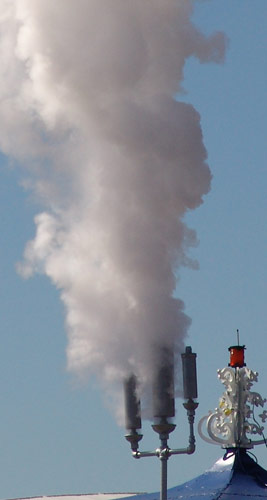
The origin of the Belle of Louisville’s whistle is unclear, while what’s clear is that it is a three-bells cast-iron whistle, that is the original whistle when the boat first came out as Idlewild, according to Fred Way jr.
But there is a story where the three bells of the whistles are said to be coming from. Capt. Ernest Wagner as well as Virginia Eifert have written that today’s Belle of Louisville whistle is a combination of whistles from three different boats: One is said to come from the excursion steamer Princess, one from the America and the third one from a Pittsburgh area boat around the turn of the century where nobody seams to remember the name of.
While this is a nice story, it seams unlikely that this story is true. As Alan Bates comments: “I think Captain Ernie was pulling some reporter’s leg. Those three whistles are made exactly alike in every detail. The excursion Str. America burned on September 8, 1930. Cooley’s America sank August 13, 1926, at New Orleans. The Princess burned in January, 1928. The Coney Island’s Princess was crushed in January, 1918. Fred Way stated the Idlewild had this whistle when new in 1915. The whistle was probably new and more than likely made in one place at one time.”
Virginia Bennett most likely took her information from the article Capt. Wagner wrote.
Videos
Calliope
In May 2002, Travis C. Vasconcelos offered a lot of details about the current and an earlier calliope of the Belle of Louisville at the Stemboats.org Message Board which we have put together here.
The current calliope aboard the Str. Belle of Louisville features whistles built as replicas of Thomas J. Nichol (the premiere builder of steam calliopes, based on Vine Street in Cincinnati 1890-1935) style of whistle.
What makes the Thomas J. Nichol style markedly different is the use of copper for the “bell” of he whistle. Most other builders used brass for the entire construction. The copper is said to have a “more pleasant” ring to it.
The Str. Delta Queen calliope whistles are Thomas J. Nichol originals. However, they have been gold electroplated to reduce labor of polishing. The calliope I perform on, the Indiana Ujniversity Steam Calliope is one of the “Three Sisters”, of which the Str. Delta Queen is also a member.
The “Three Sisters” are 3 virtually identical Thomas J. Nichol calliopes built in the winter of 1923 at Cincinnati, OH. They were the first 32 note Thomas J. Nichol steam calliopes. Each of the “sisters” has a unique “chiff”. The Str. Delta Queen’s “chiff” is her middle “C”, the Indiana University has her’s on “D” above middle “C”. I do not know where the Str. Avalon (the other of the “Three Sisters”) chiff was/is (maybe we can get Capt Gabe on here to tell us?). See below for more details about what a “chiff” is.
The calliope currently on the Str. Belle of Louisville was patterened after measurements taken from the Indiana University Steam Calliope and the Sparks Bros. Circus Steam Calliope (a later built 32 note Thomas J. Nichol original).
David Morecraft, of Peru, IN. and I became friends through the process of getting the sale for the Str. Belle of Louisville and worked together to install the instrument. The whistles were installed on 18/April/1988. We had a great time performing at the “Tall Stacks” festival that year. The new whistles added a pride to my performing, I can assure you!
Over the successive years, I can say this. The instrument has functioned flawlessly. The tone is pure Nichol and cannot be beat!
I worked on Str. Belle of Louisville from 04/81 – 09/95. It was a great pleasure to perform on that calliope. To this day, I remain proud of that instrument and visit her regularly. I know of no serious maintenance has been performed on the whistles since I left the vessel. It is a testament to the builder. They truly are fine work!
More information about the Belle of Louisville’s calliopes added by Wesley Paulson: The Belle of Louisville had three steam operated calliopes and one air-operated. The first was installed in April 1924, at Memphis, TN. This one was built by Thomas J. Nichols as one of the famous “Three Sisters”, one can be found on the Delta Queen. The calliope was sold separately in the 1962 auction of the boat. The buyer was Capt. Gabriel Chengary, actual head master of the Delta Queen. The next one was the air-operated calliope donated by William J. Smock, built by Kozat. In April 1966, Earnest J. Wilde constructed another steam operated calliope for the Belle of Louisville with a brass and copper keyboard and 32 whistles. The instrument caused many problems and many parts had to be changed. In the early 1980s the whistles came to their end. On April 18, 1988, new whistles were installed made by David Morecraft of Peru, IN, who was building replicas of the Thomas J. Nichols steam calliopes.
What is a “chiff”?
Travis C. Vasconcelos explains: A chiff is a shreek or “wildcat” sound made by a steam whistle before it settles down into it’s note. Also known as “biting”.
There are three situations that cause this.
The First and most common is a slight un-evenness in the cut of the base of the whistle bell. Although usually less than an 1/8″th of an inch, this will cause a “chiff”. The repair is the replacement of the whistle bell. If you plain off the suspect metal you can shorten the bell of the whistle. Shortening will raise the pitch. Just 1/8″th can cause a half step, depending on scaleing.
The other situaion which can cause chiffing is drastic and quick changes in steam pressure. This is not common on steamboats. However Circus Wagons experience this from time to time. Ususally caused by the bouncing of the boiler. More common in atmospheric burner systems. Power burners usually compensate well for it.
The last chiffing situation is damaged whistle components. Namely damage or dentiong to the bell of the whistle and/or a bent threaded support rod.
The Str. Delta Queen and IUPUI (Indiana University) chiffs are part of the intrinsic character of the particular instrument. I can tell either instrument on most recordings or in person based on this unique characteristic.
The Str. Delta Queen calliope has gold plating, which substancially mellows the tone. However, in recordings prior to the plating, she and the IUPUI were almost identical, save for the half step difference in the “chiffing” notes.
